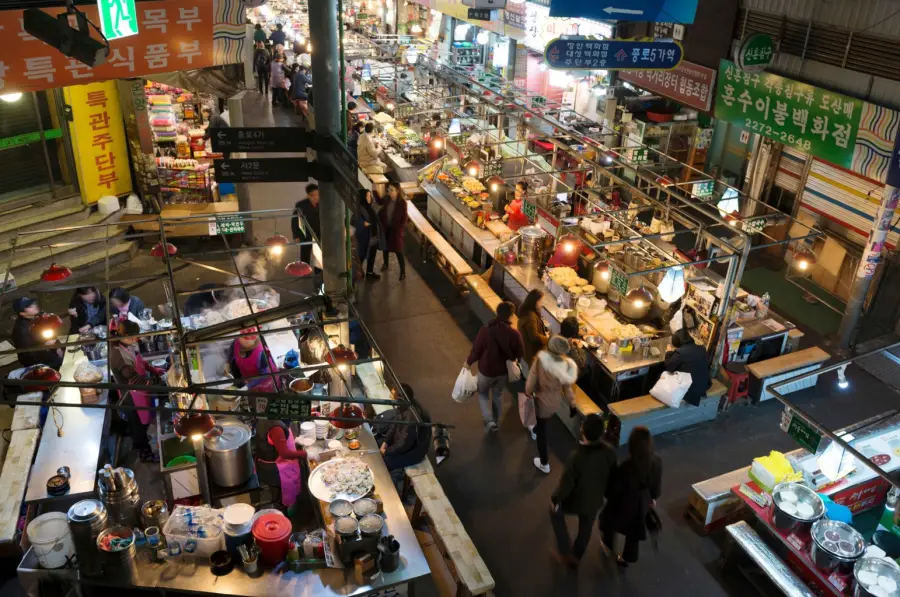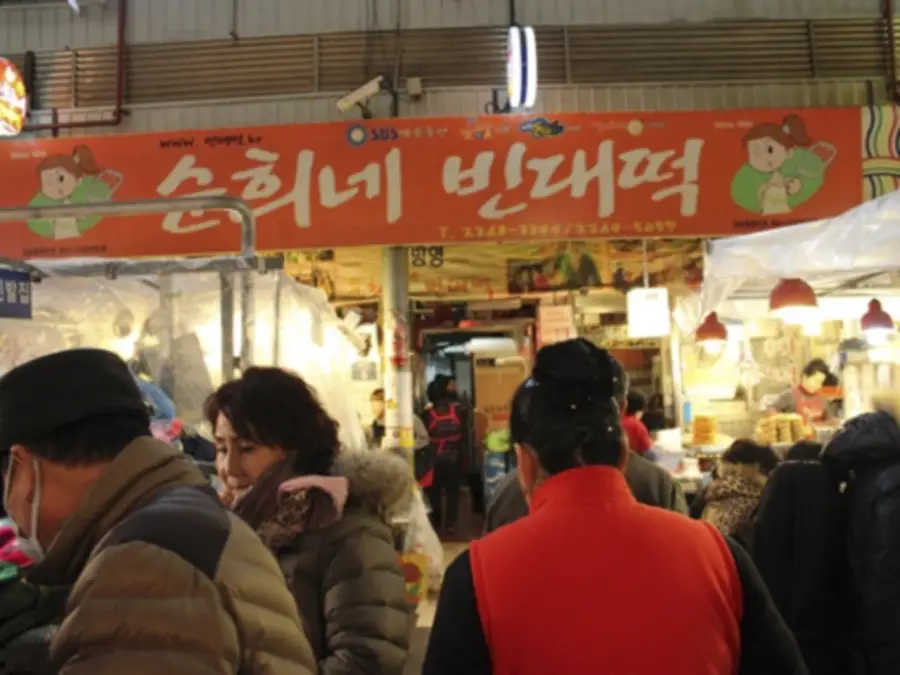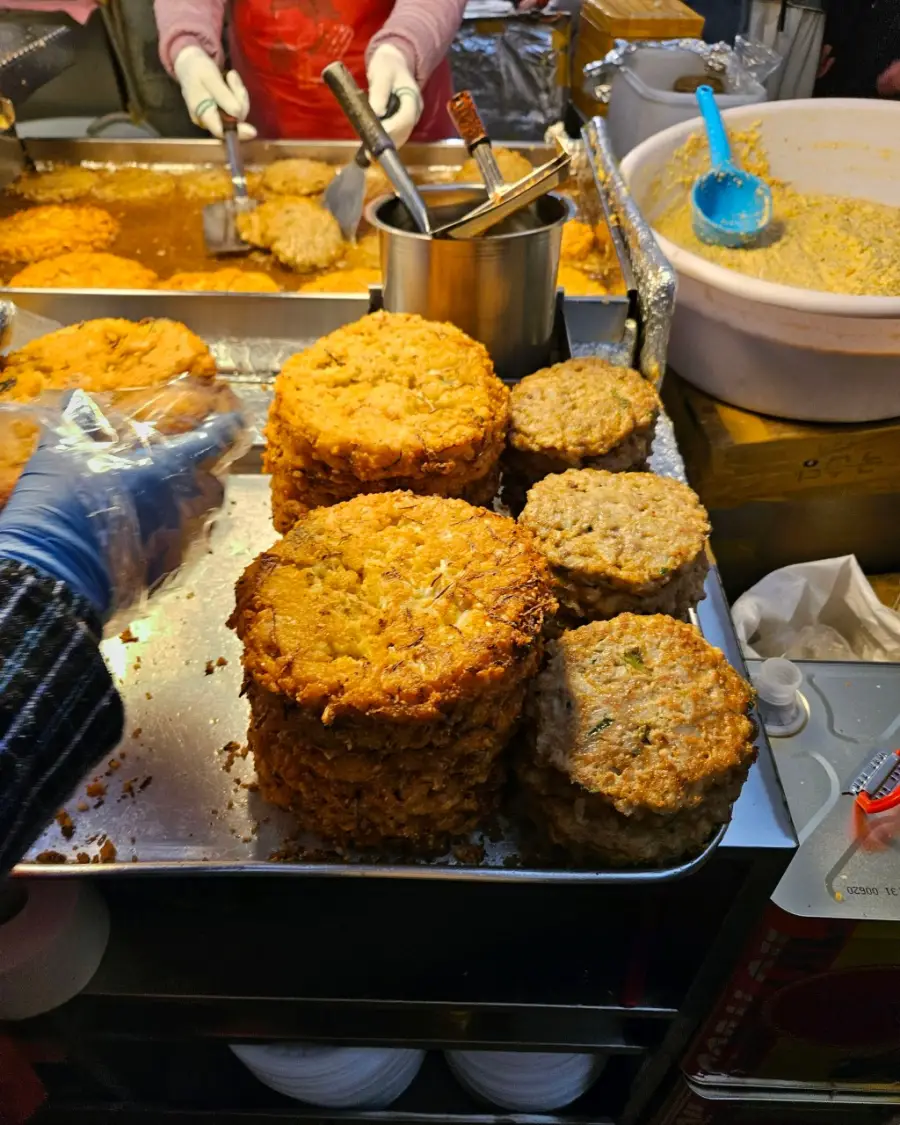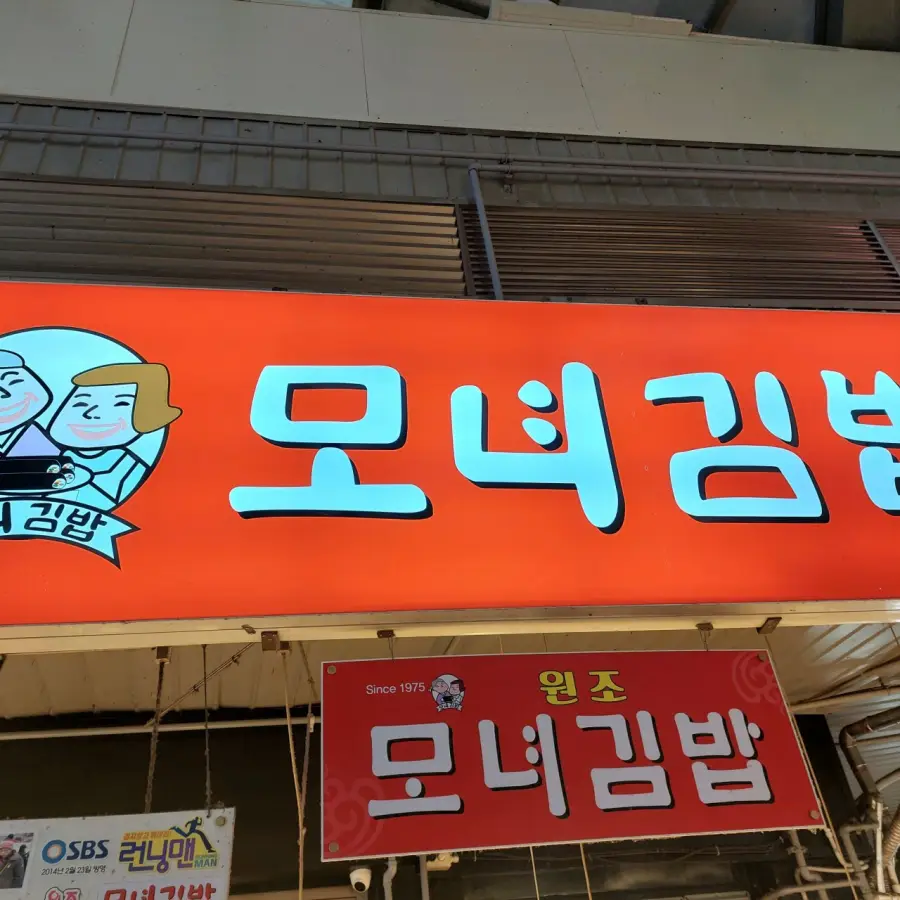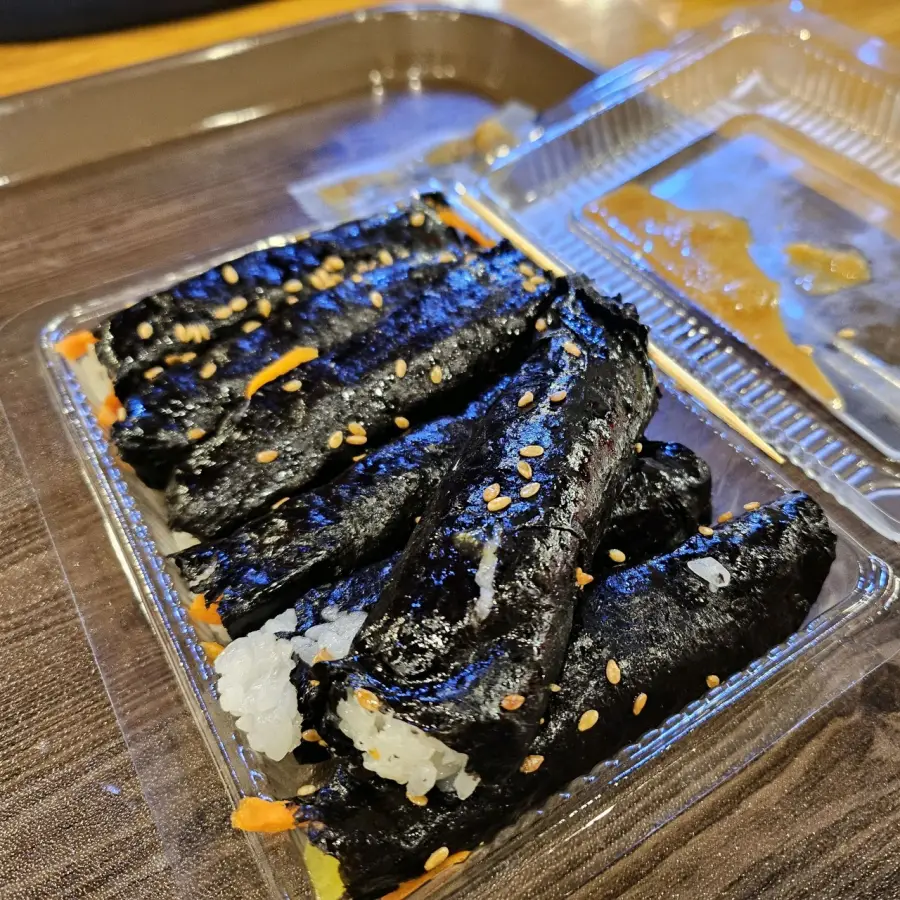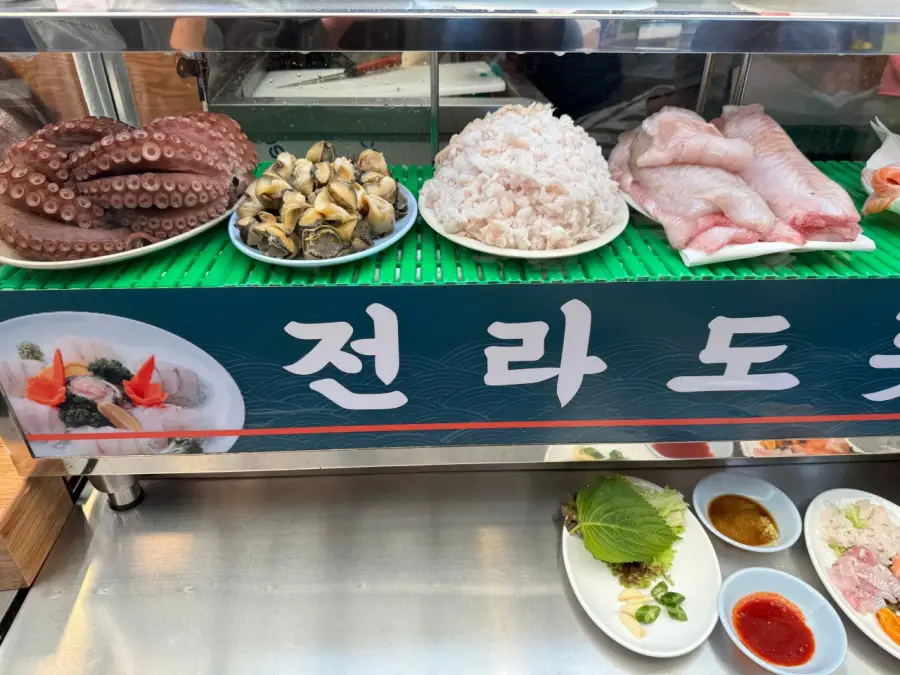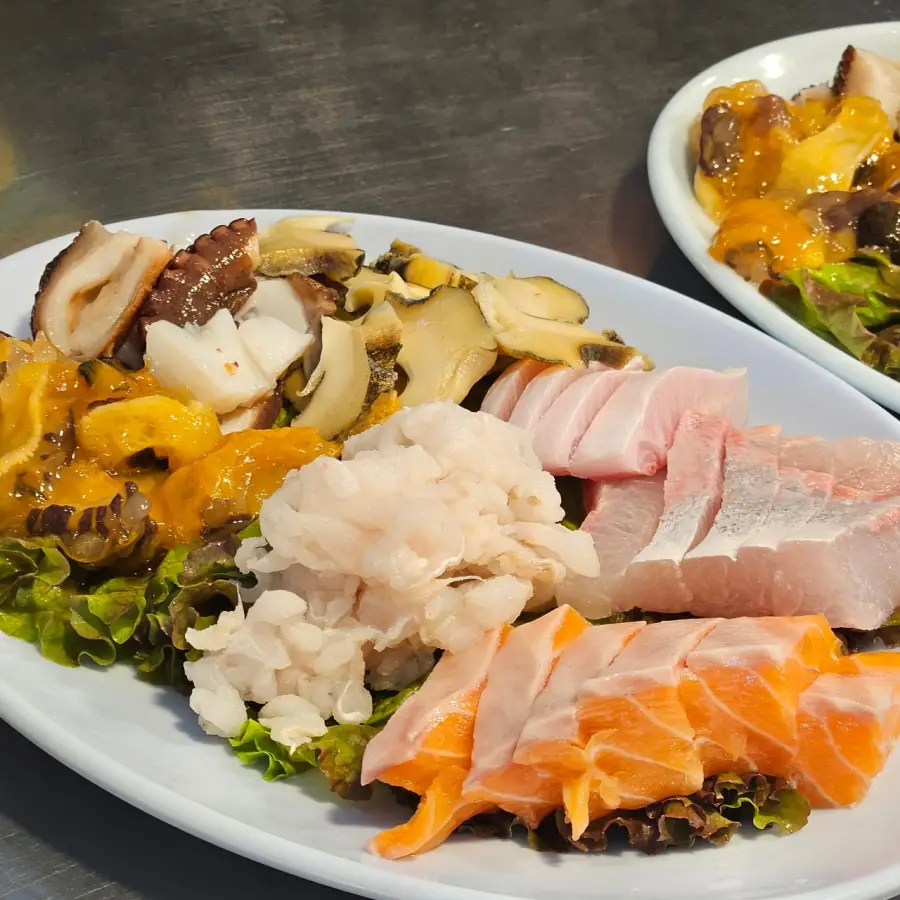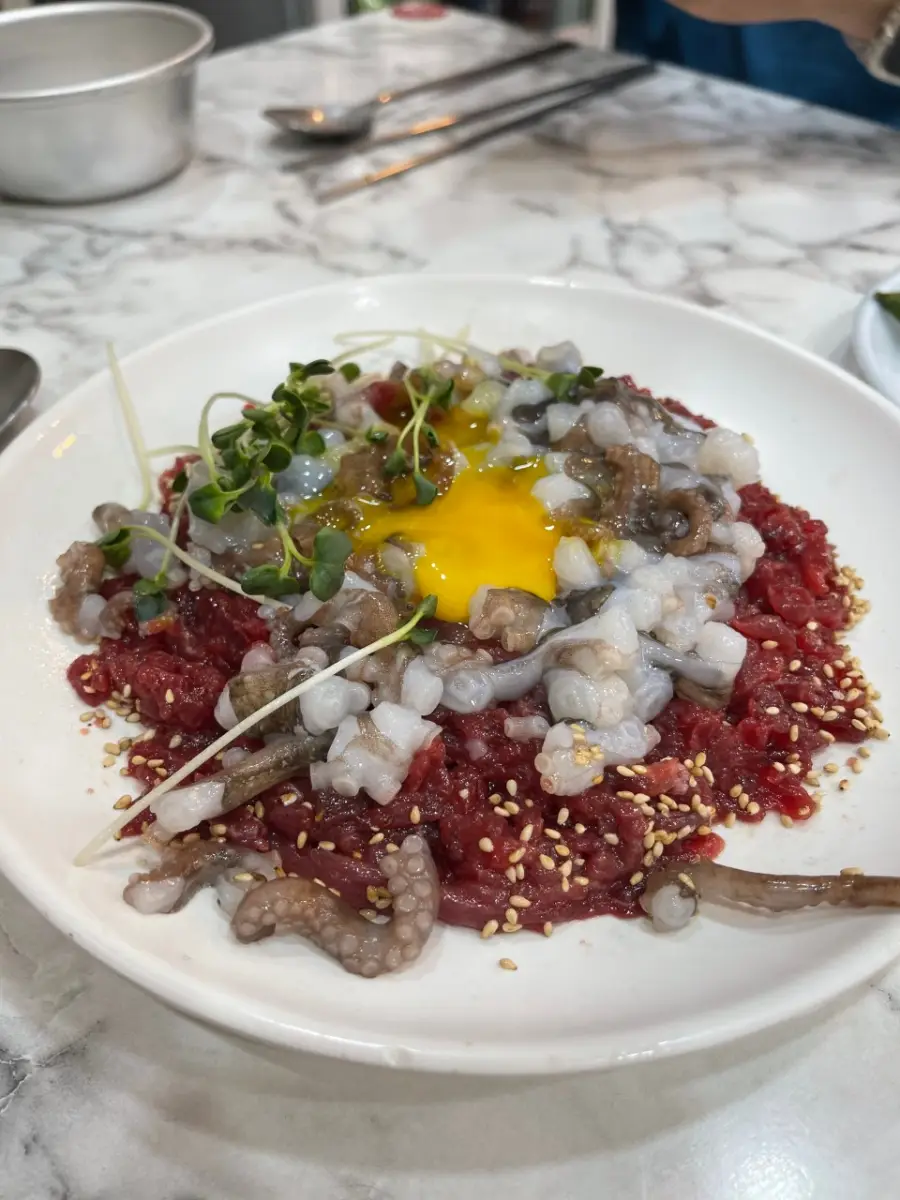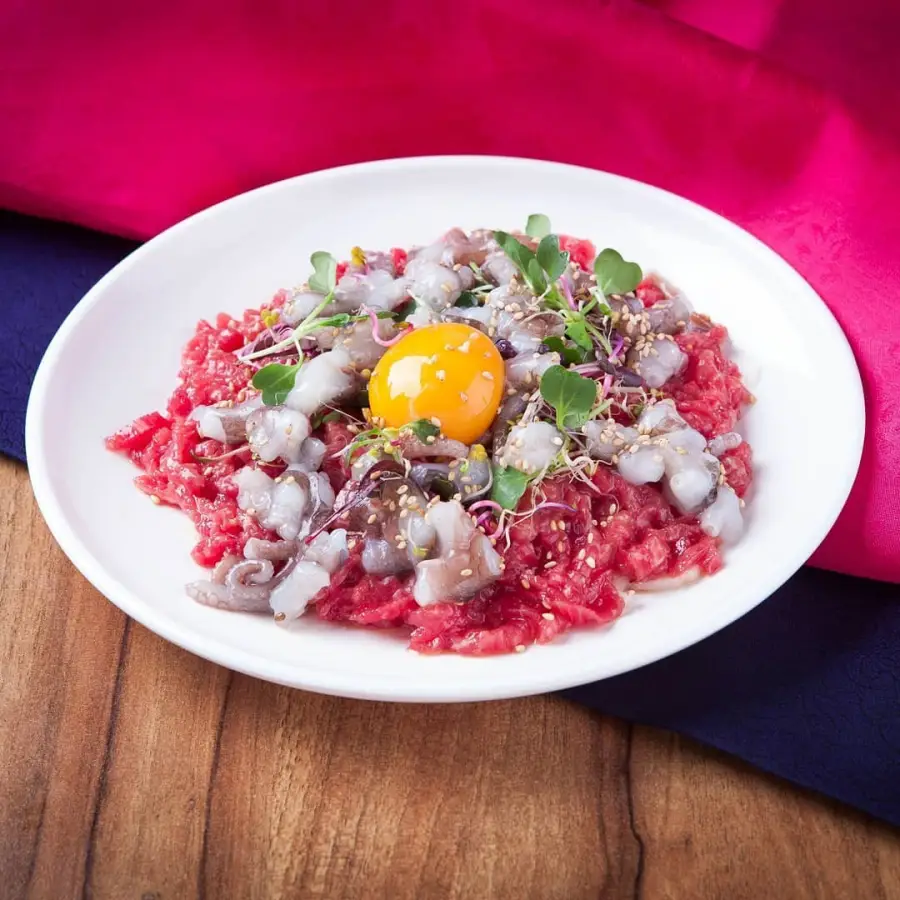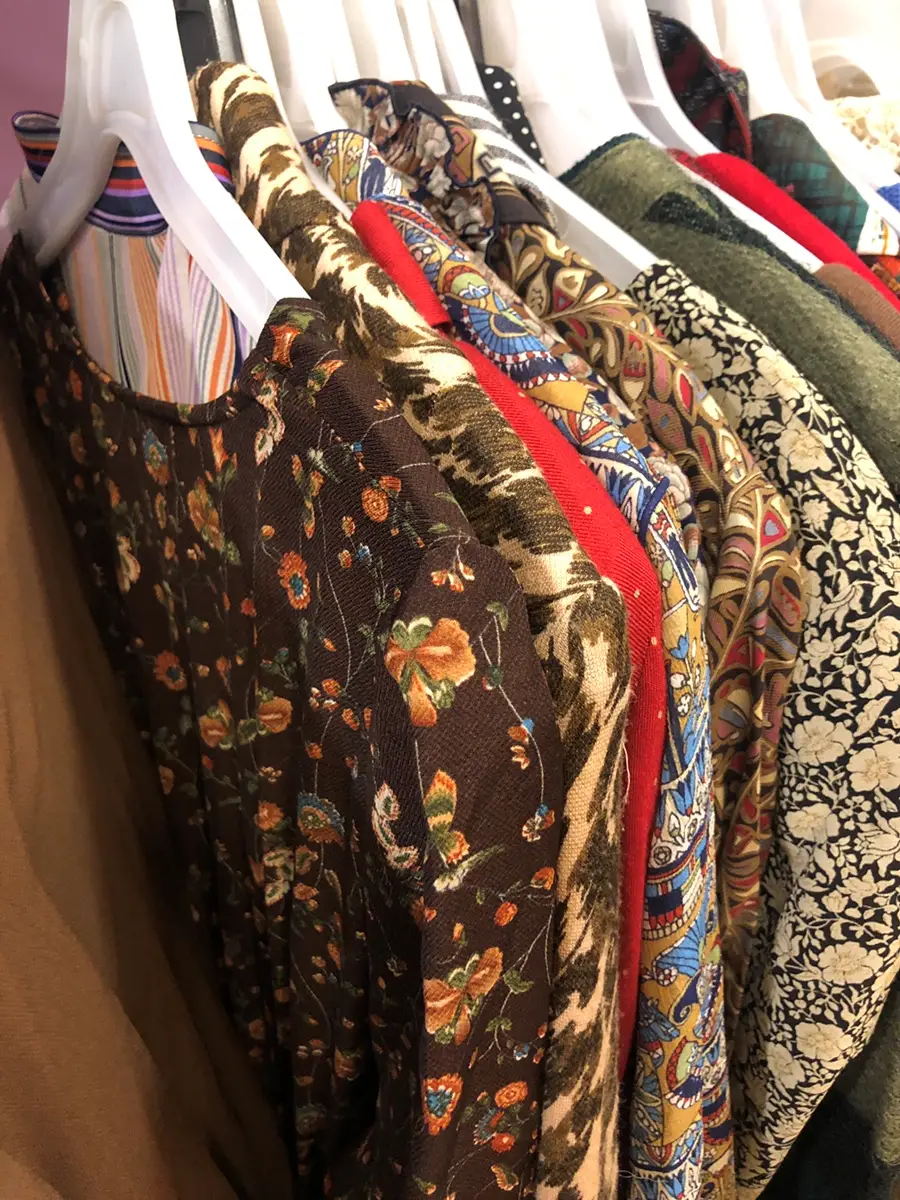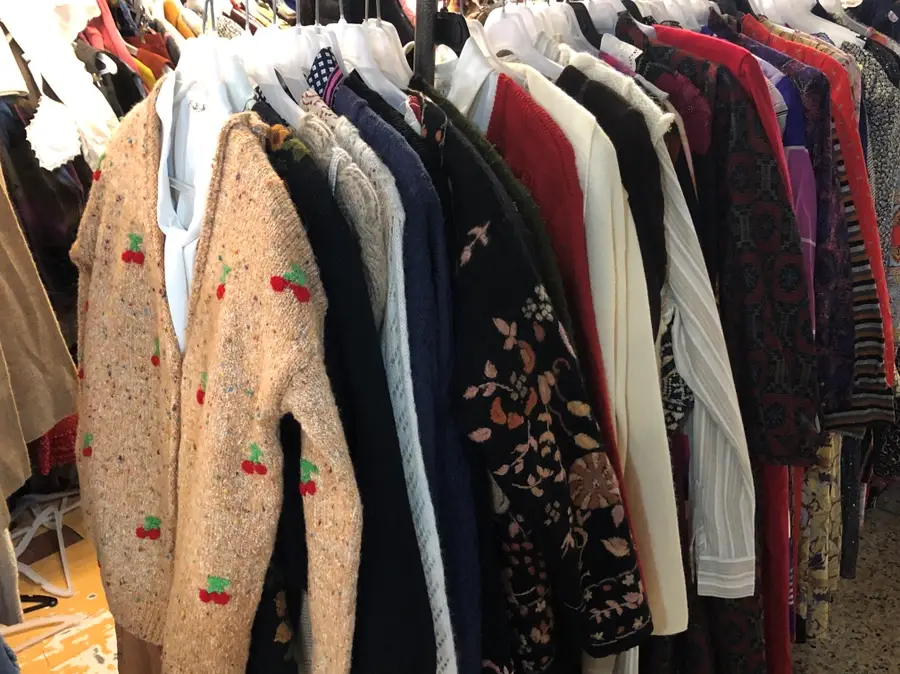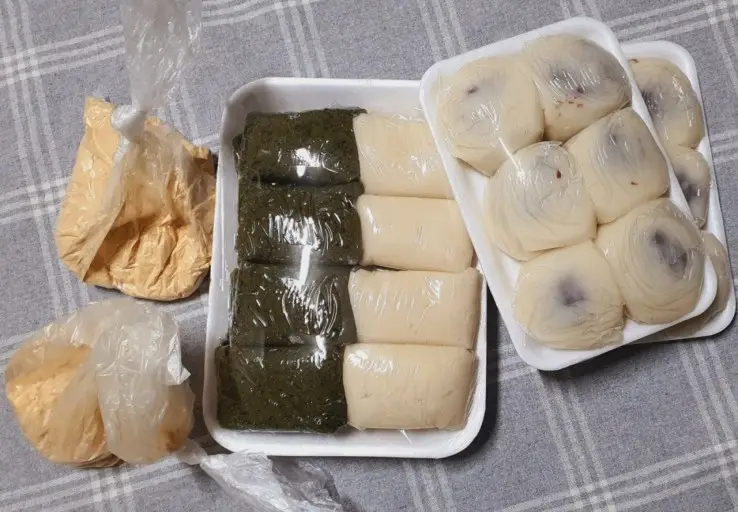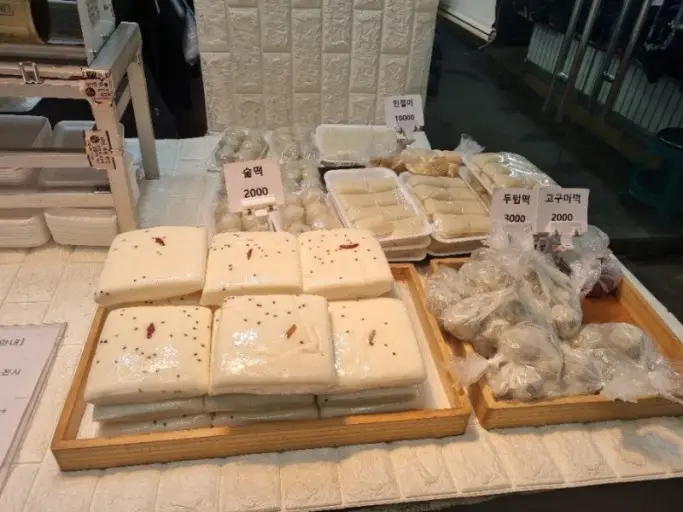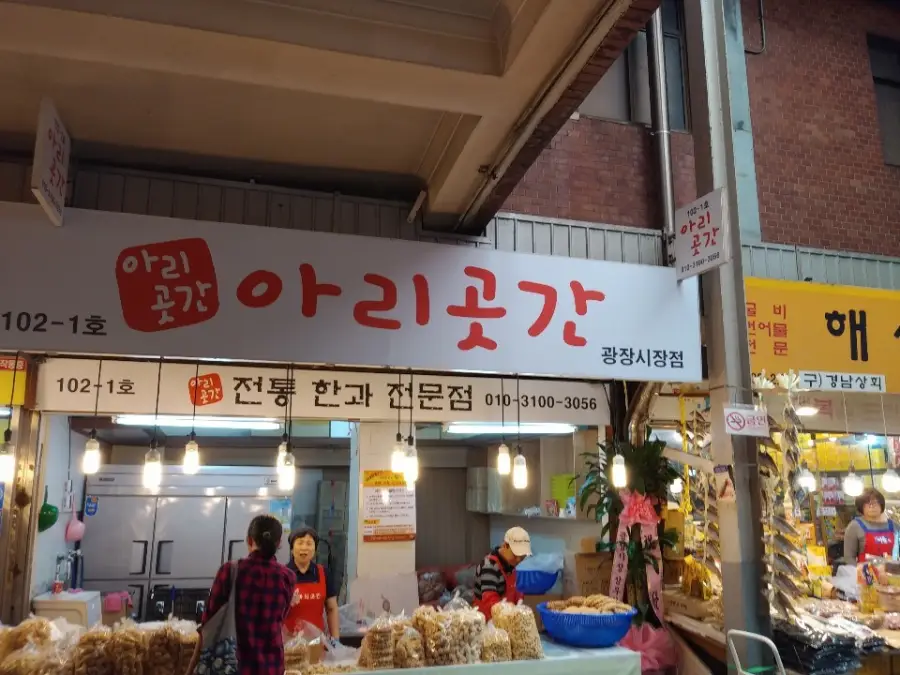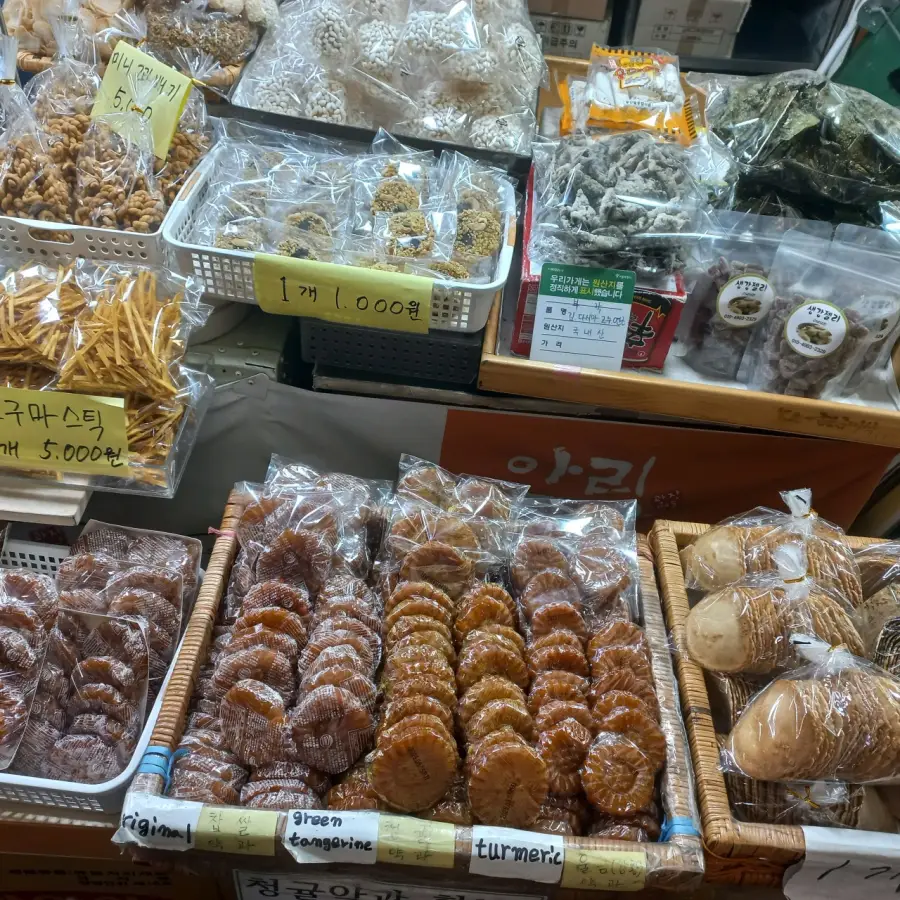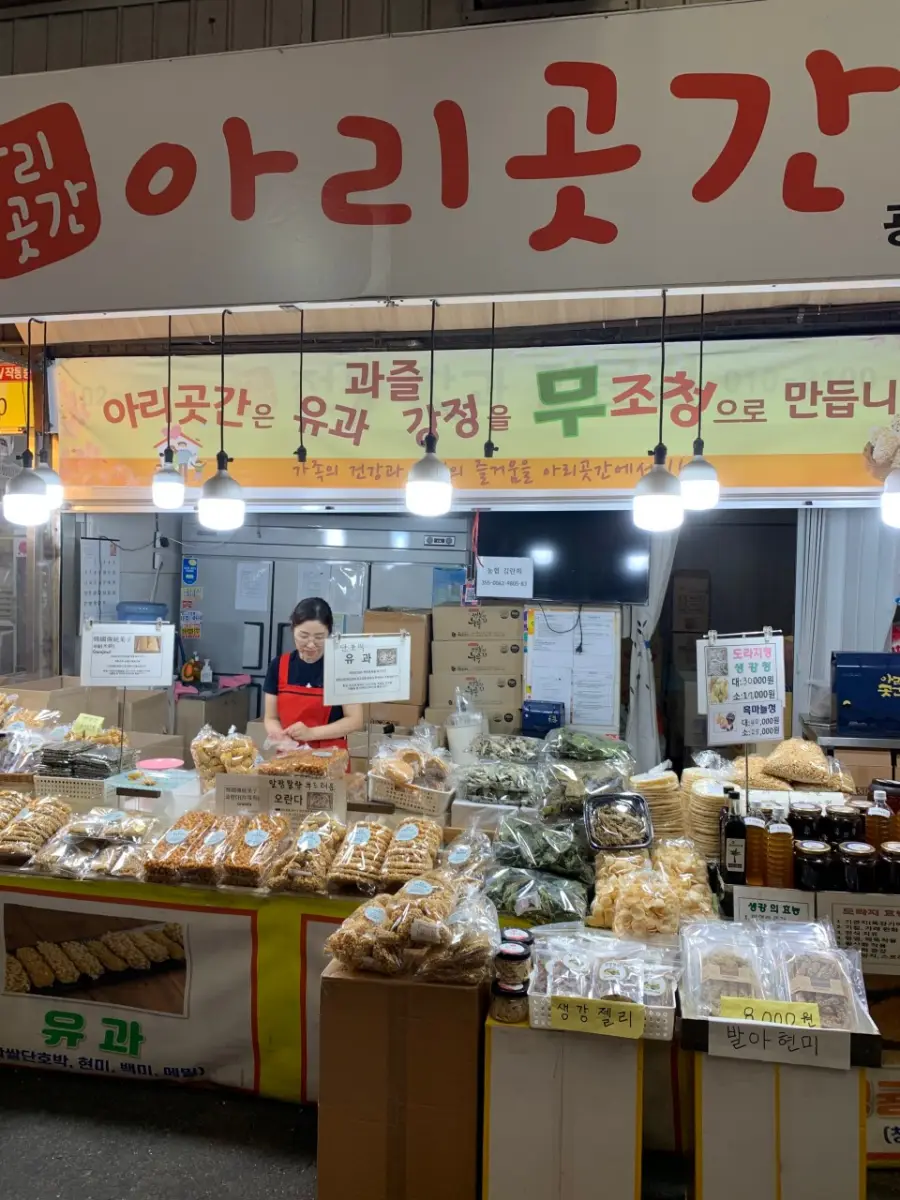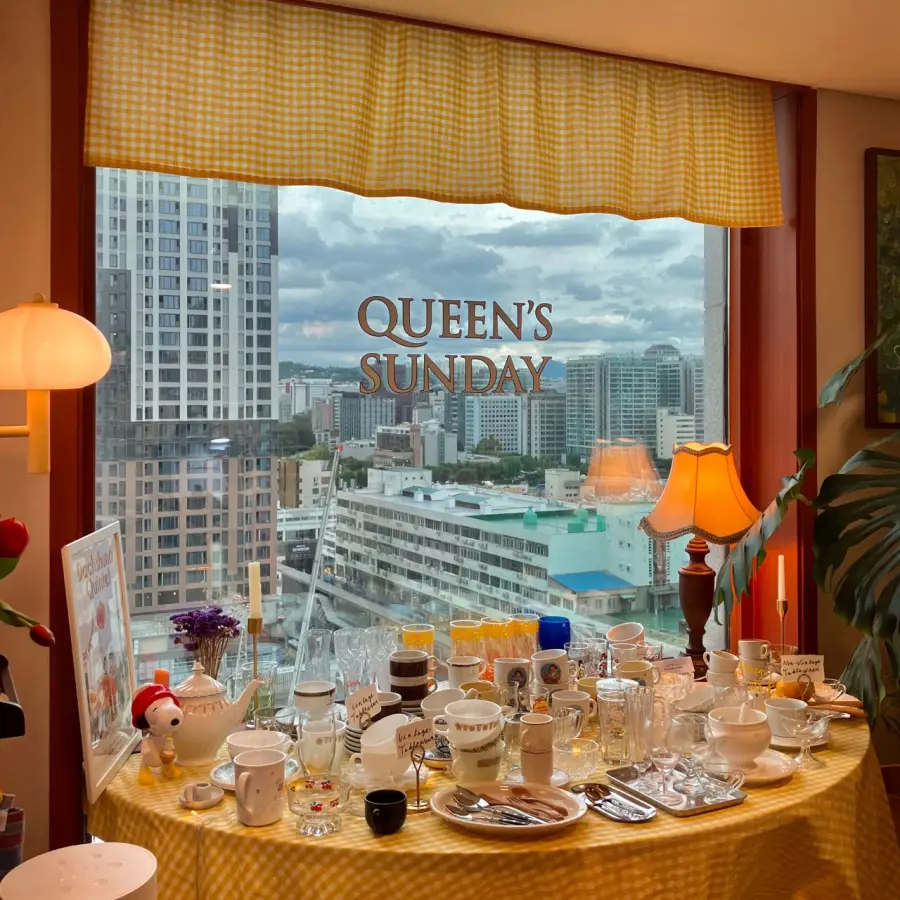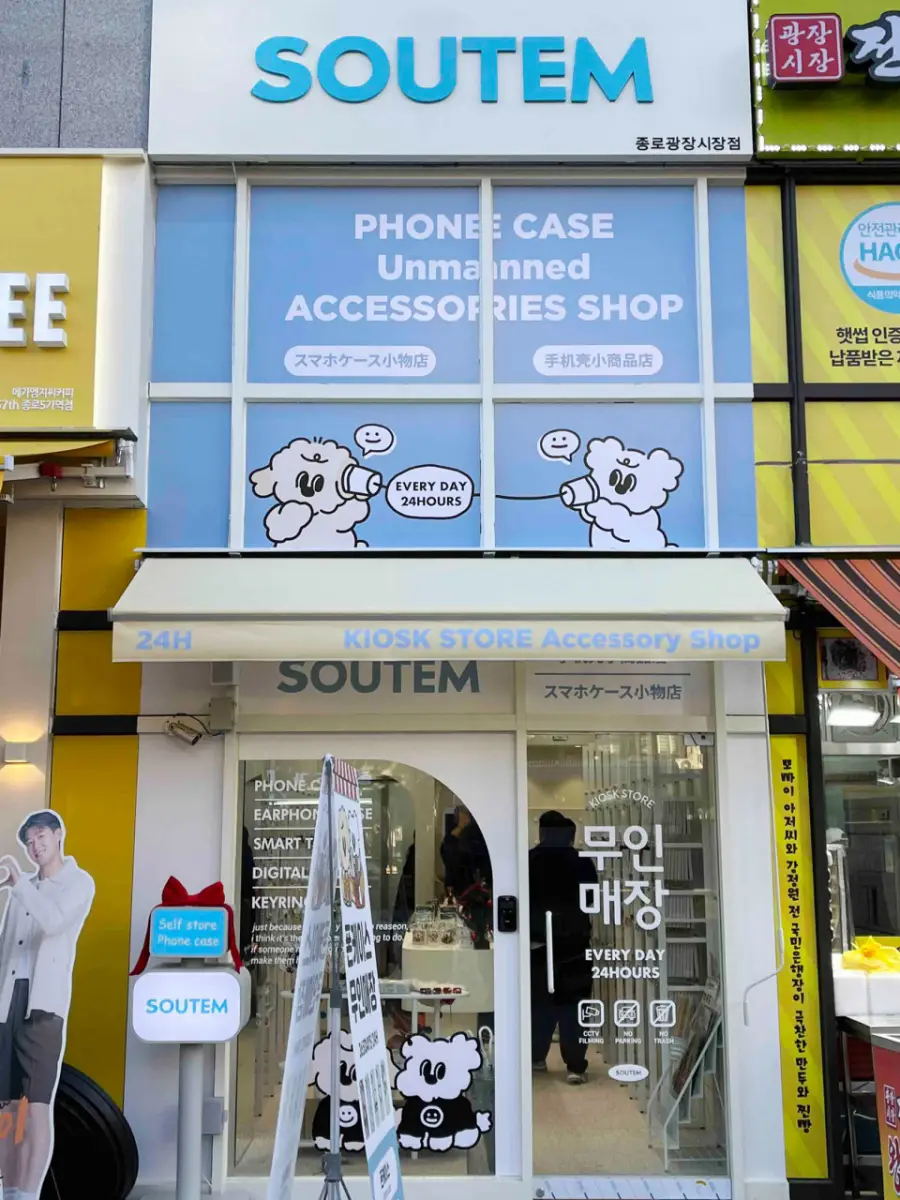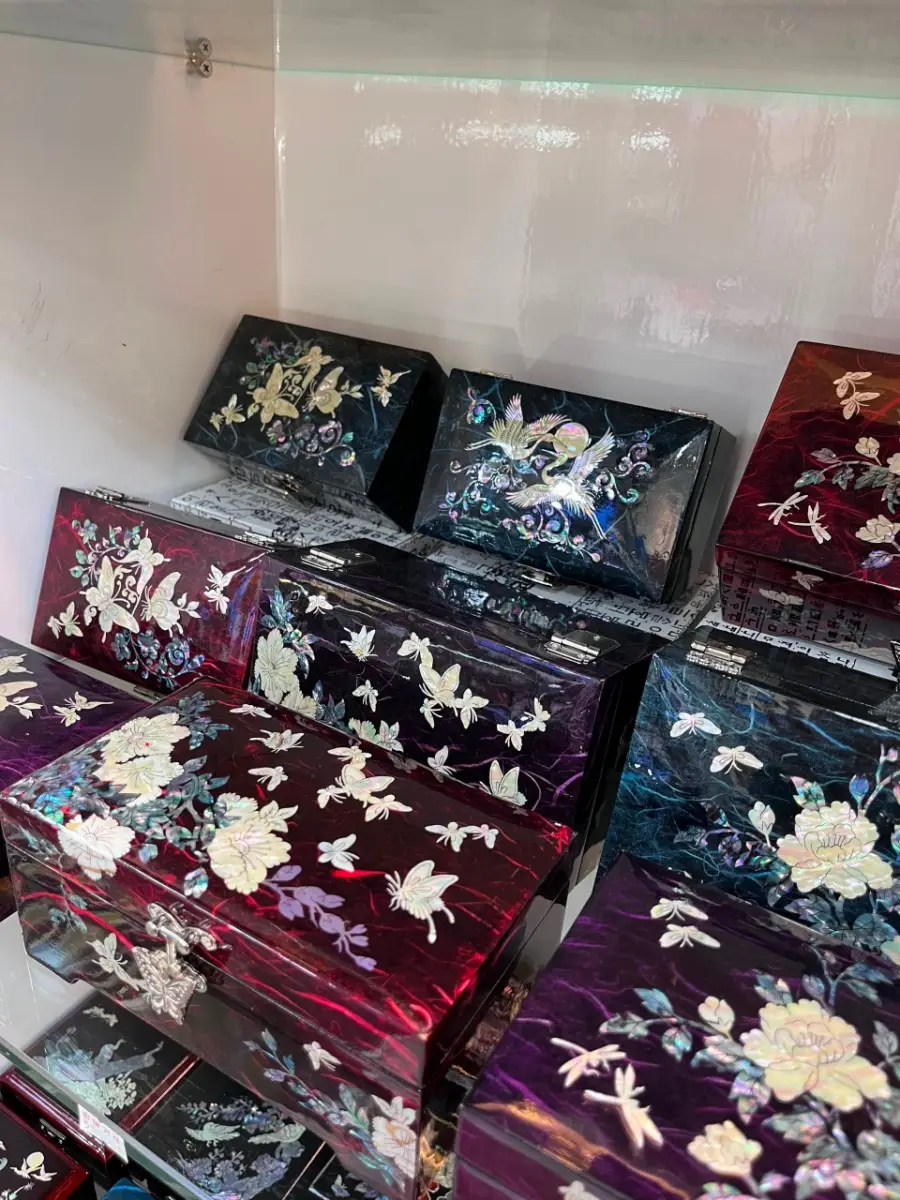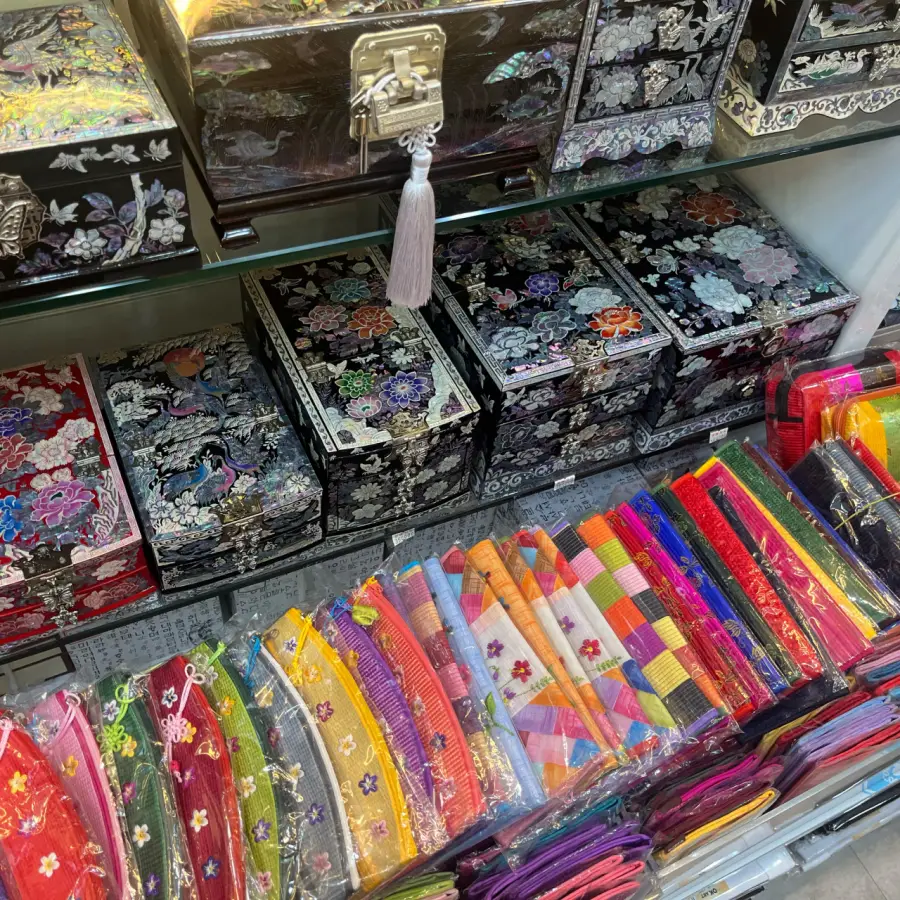Gwangjang Market
Seoul’s oldest traditional market, established in 1905
Located in the heart of Jongno, right beside Cheonggyecheon Stream, Gwangjang Market is Seoul’s most vibrant traditional marketplace. As you enter the market, you’ll be greeted by the mouthwatering aroma of sizzling bindaetteok (mung bean pancakes), the sweet scent of tteokbokki (rice cakes in spicy sauce), and the cheerful voices of merchants that fill the air.
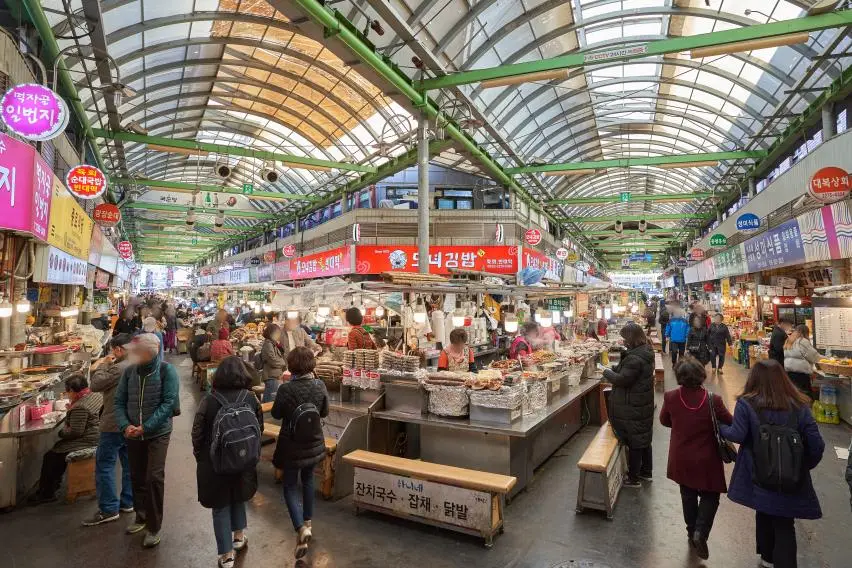
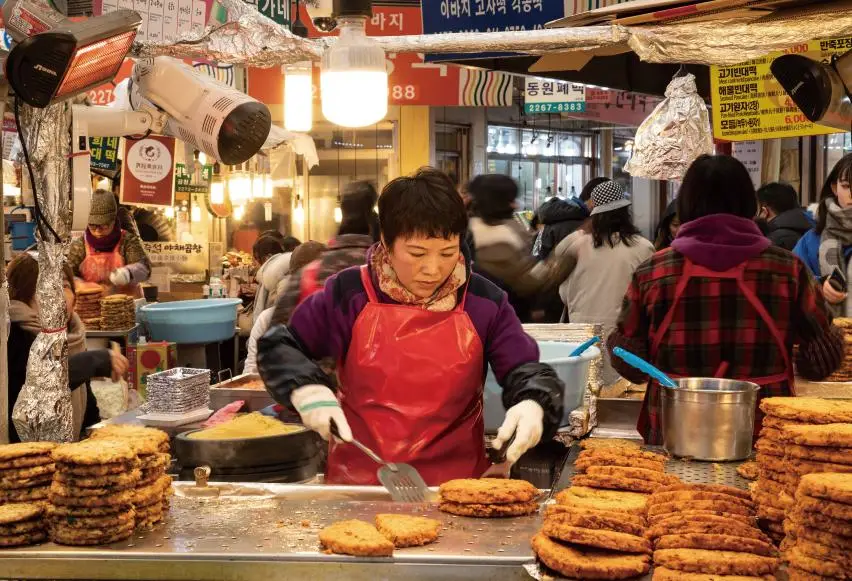

Here, you can discover a food paradise ranging from the Instagram-famous “addictive” gimbap to the legendary bindaetteok that Seoul locals have loved for generations. As you explore the maze-like alleys, you’ll find an enchanting mix of century-old establishments and trendy new shops, showcasing the market’s ability to bridge generations.

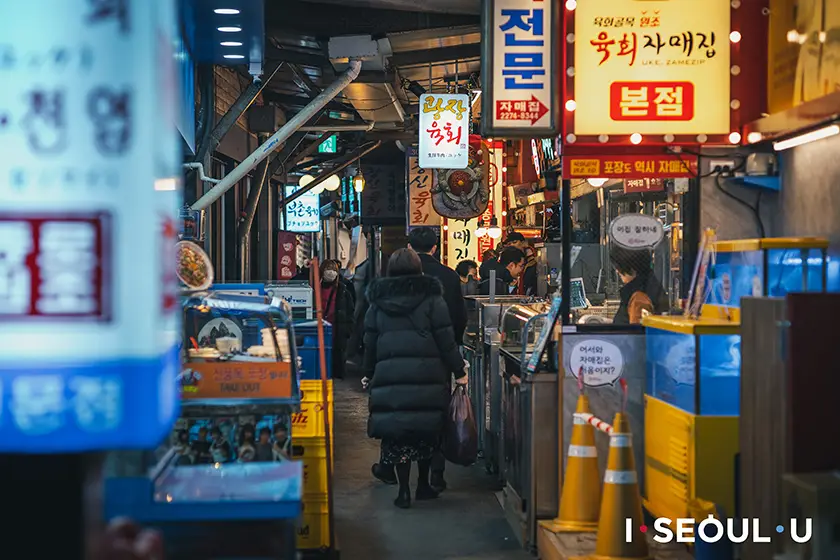
On weekends, Gwangjang Market bustles with international tourists and locals searching for their favorite foods. Come experience this unique place where Seoul’s hottest trends meet its most authentic local charm!
1. Overview
Introduction to
Gwangjang Market
- What It’s Like
- At a Glance
What is Gwangjang Market Like?
A comprehensive traditional market established in 1905, where you can find everything from local food and traditional clothing to textiles and fresh produce in one place.
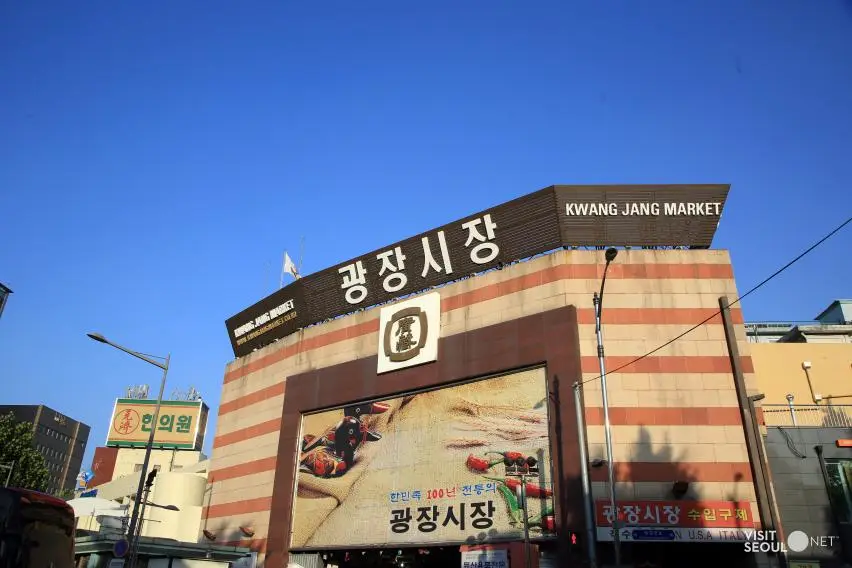
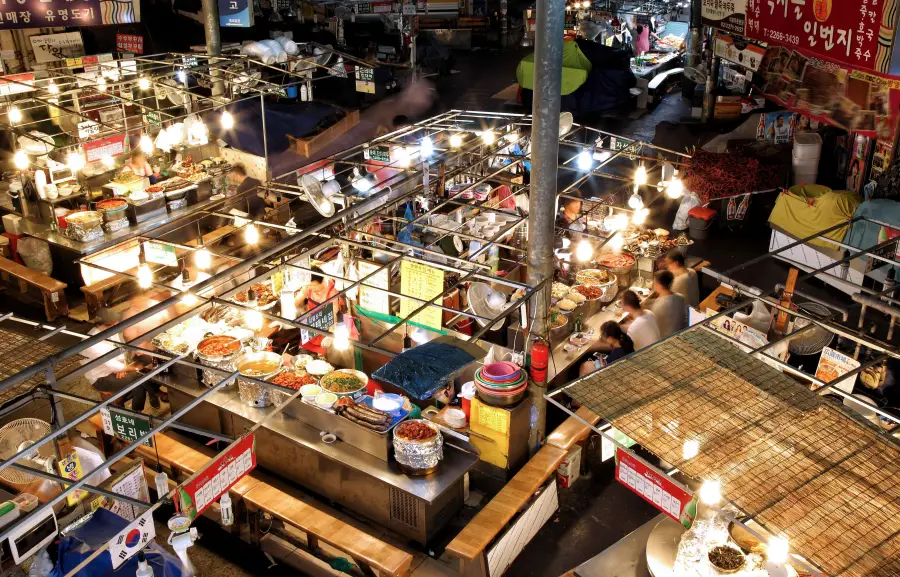
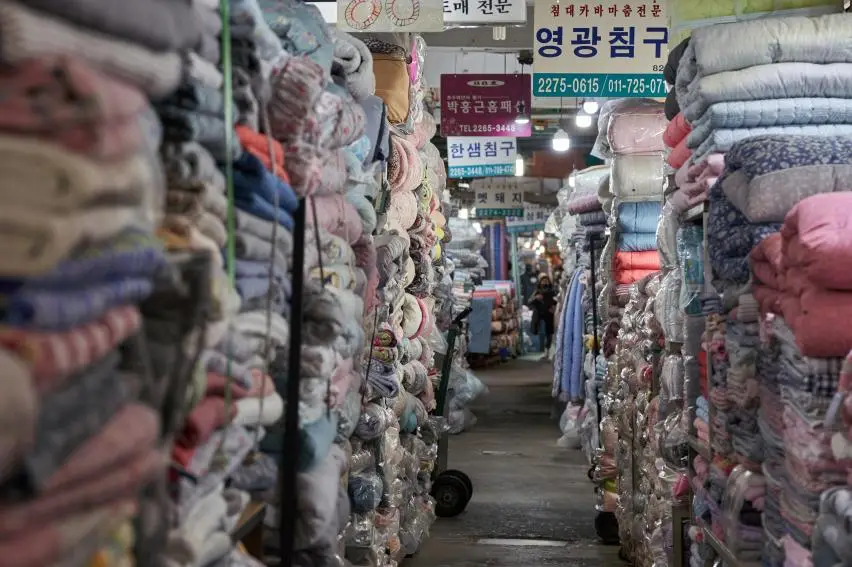
Gwangjang Market is Seoul’s oldest traditional market with over 100 years of history. Opening in 1905 during the Japanese colonial period, it became Korea’s first permanent marketplace. While it initially started as a market focused on clothing and daily necessities, today it has transformed into a bustling destination for food lovers and those seeking to experience Korean traditions. Located where Jongno and Cheonggyecheon Stream meet, this market stands as a living cultural heritage that has grown alongside Seoul’s history.
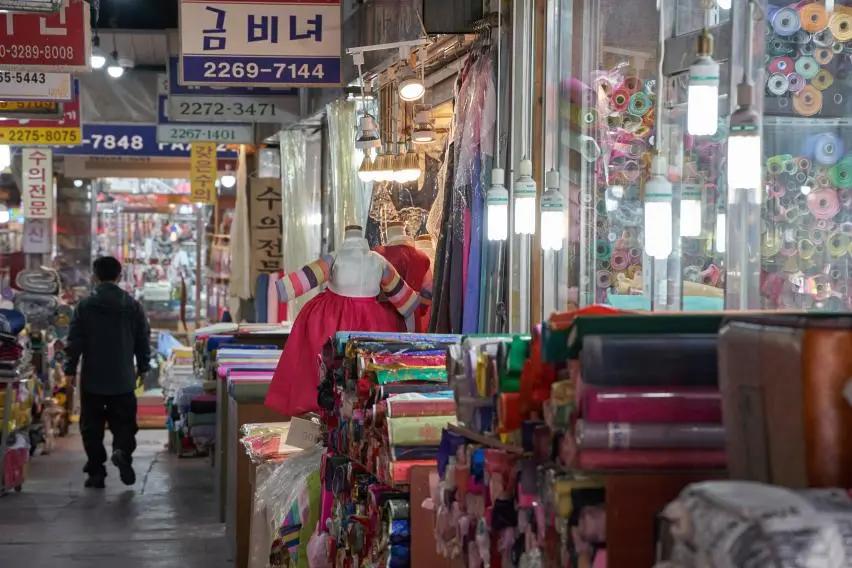
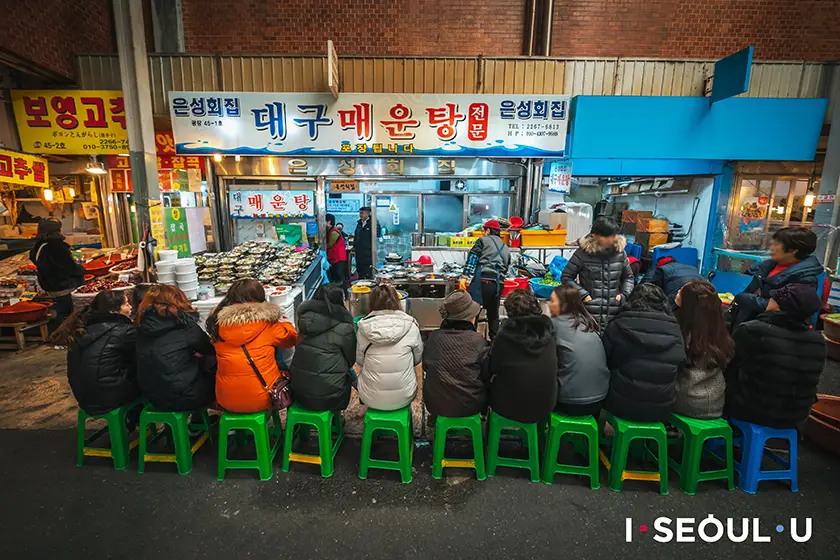
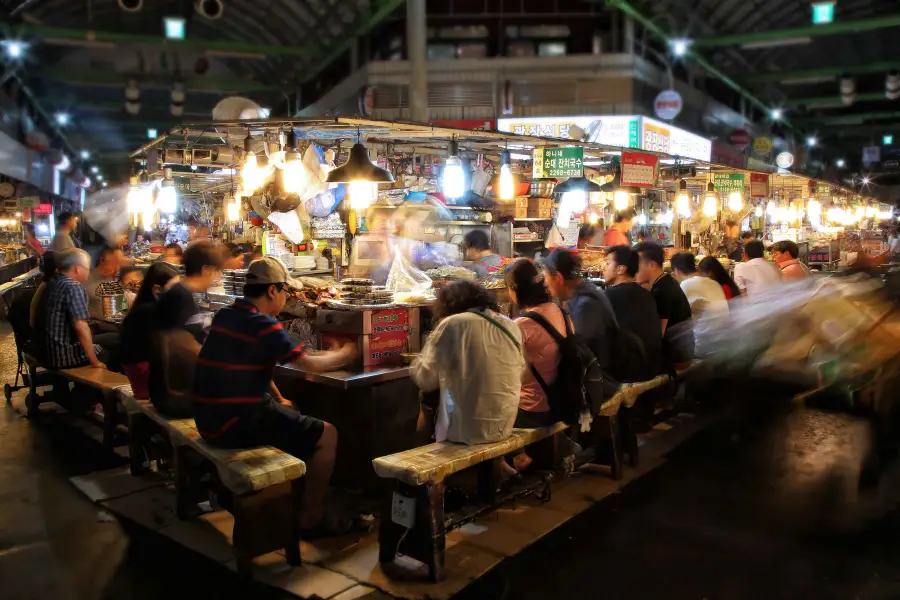
What makes this place special is its unique atmosphere where tradition meets modernity. From wholesale shops selling hanbok (traditional Korean clothing) and fabrics to fresh agricultural and marine products, and delicious street food – you can find everything in one place. When it comes to Gwangjang Market, the food is absolutely unmissable. From crispy and savory bindaetteok (mung bean pancakes) to juicy “addictive” gimbap, and fresh seasonal seafood – you’ll find all the delicious foods that even Seoul locals love to eat.
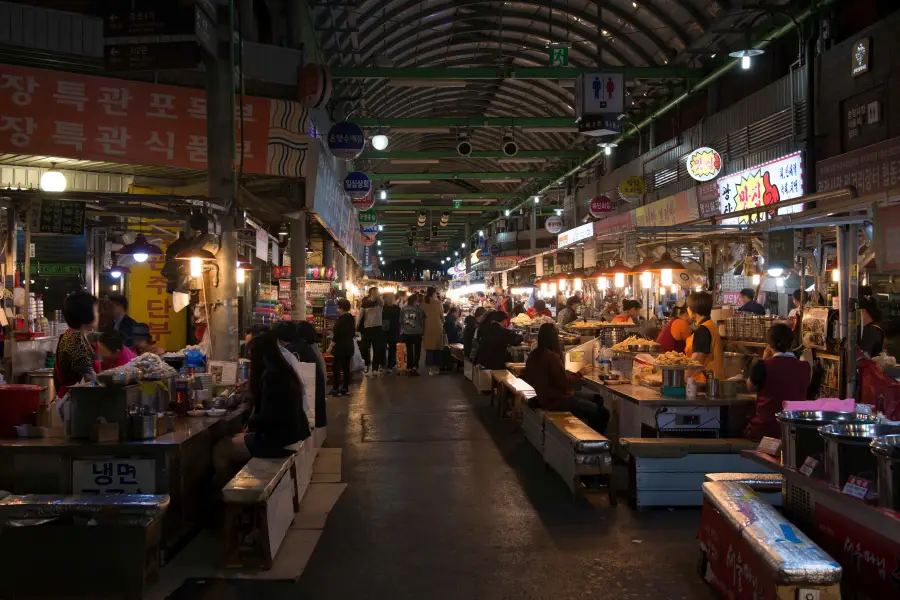
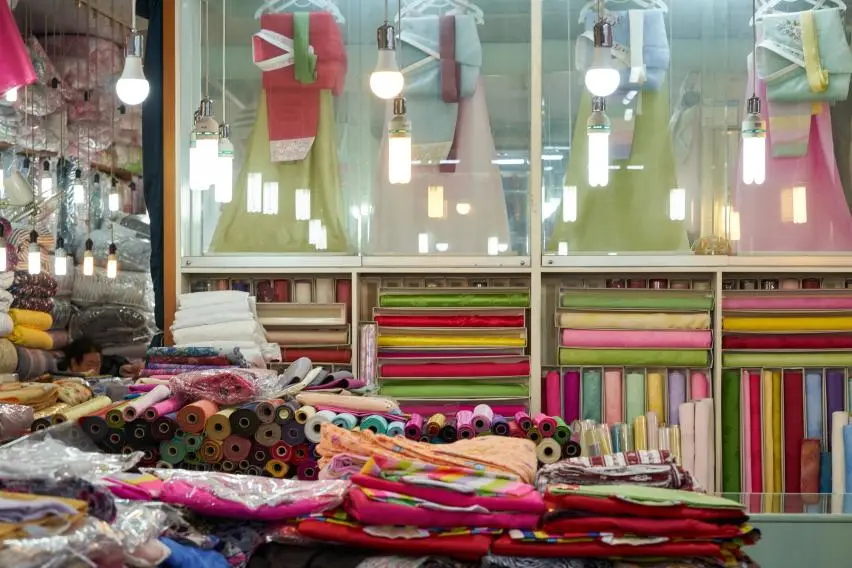
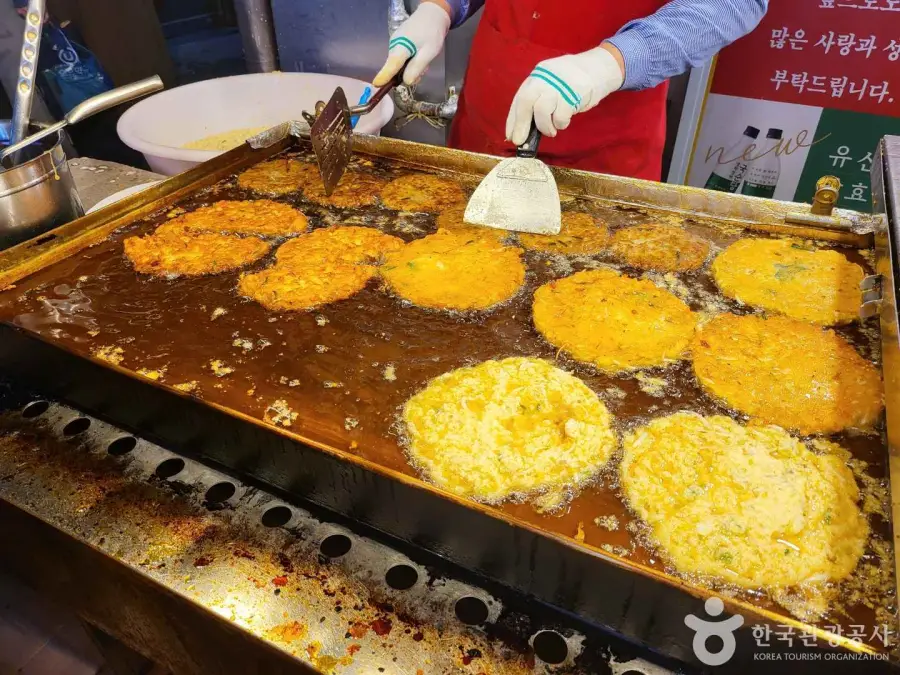
The market houses approximately 5,000 shops packed closely together. The first floor mainly features food vendors and agricultural products, while the second floor is home to hanbok, fabric, and wholesale clothing shops. The hanbok and fabric section is particularly notable as the largest of its kind in Korea, famous for the merchants’ expertise developed over many years and high-quality products.
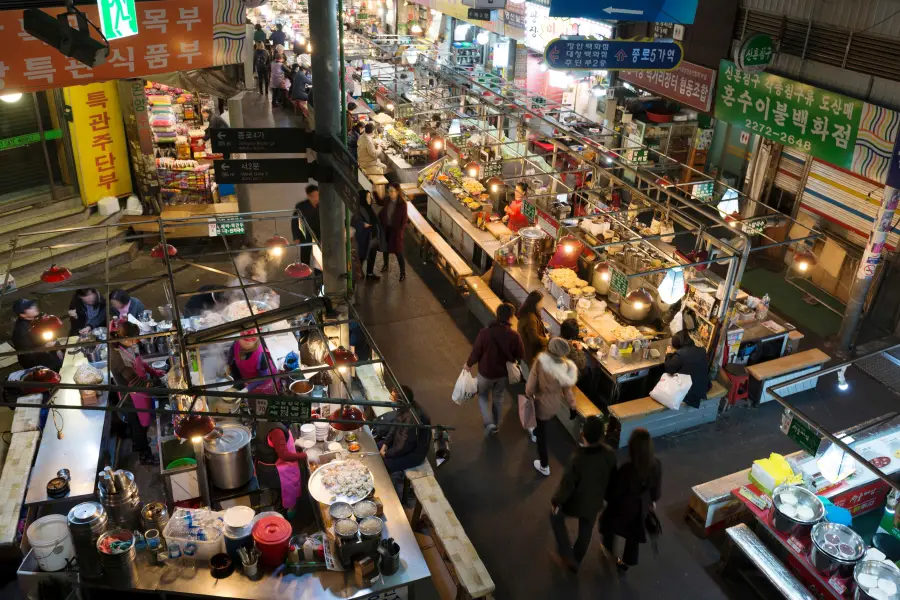
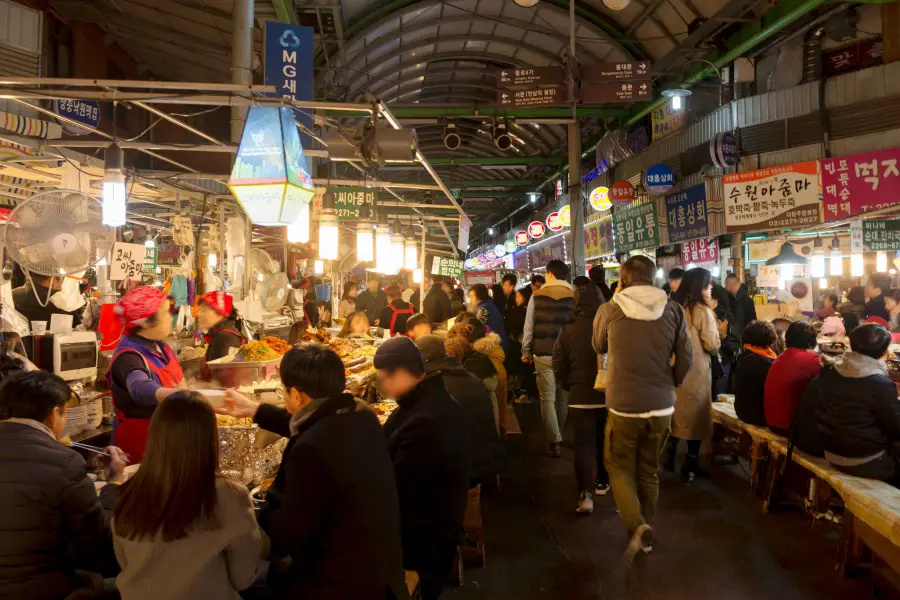
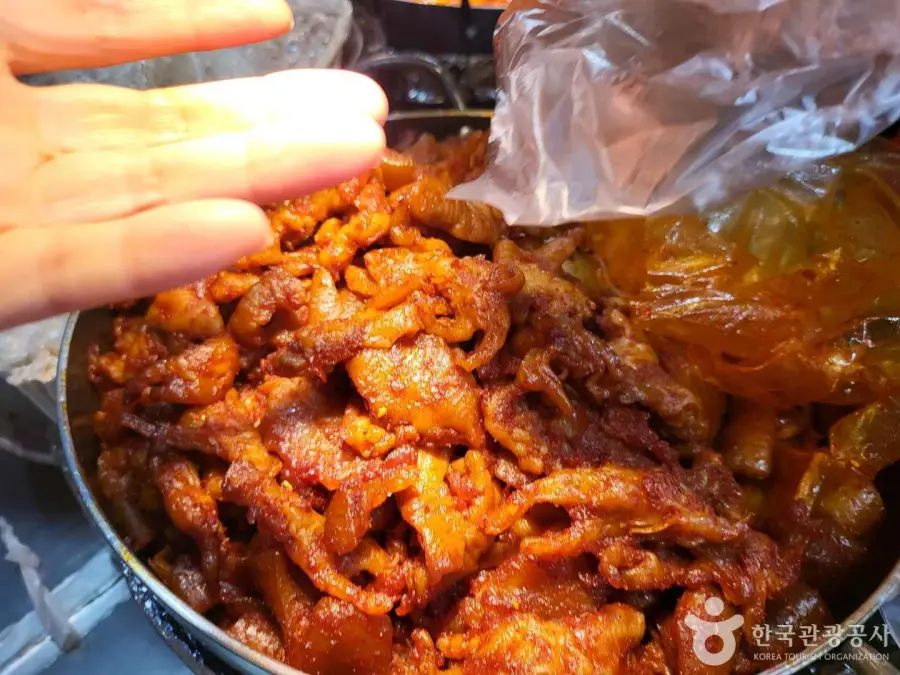
While there were once concerns about the decline of traditional markets, Gwangjang Market has recently been revitalized thanks to tourists and younger generations, becoming one of Seoul’s must-visit destinations. The narrow alleys are filled with restaurants and shops buzzing with lively conversations between merchants and customers. Its special charm lies in the analog atmosphere that you simply can’t experience in modern shopping malls.
Gwangjang Market at a Glance
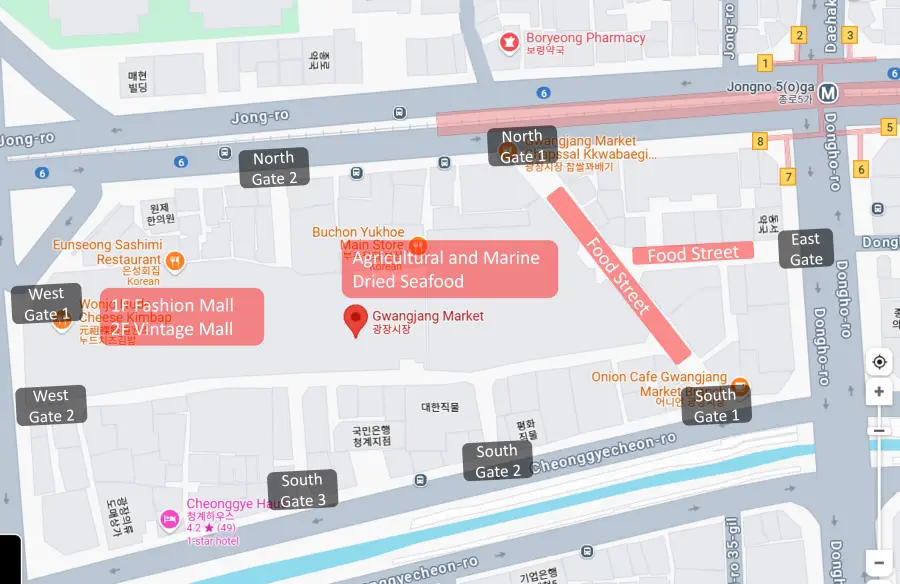
2. Information
Visit Information : Gwangjang Market
- Operating Hours
- How to Get There
Gwangjang Market Operating Hours
| Type | Operating Hours |
|---|---|
| General Stores | 9:00 AM – 6:00 PM |
| Vintage Clothing Stores | 10:00 AM – 7:00 PM |
| Food Court | 9:00 AM – 11:00 PM |
Closed: Sundays and Major Korean Holidays
How to Get to Gwangjang Market
Click ‘Here‘ to add it to Google Maps.
Line 1: Jongno 5-ga Station (Exit 8) – 1 minute walk
Line 1: Jongno 3-ga Station (Exit 7) – 8 minutes walk
Lines 2, 3: Euljiro 3-ga Station (Exit 1) – 5 minutes walk
Get off at Jongno 5-ga Bus Stop
Blue (Main) Bus: 101, 103, 105, 140, 150, 160
Green (Branch) Bus: 7025
Red (Express) Bus: 1000, 1100, 1200, 1900, 9301
3. Highlight
Things to Do in
Gwangjang Market
- Crispy Bindaetteok
- “Addictive” Gimbap
- Fresh Sashimi and Raw Beef
- Traditional Hanbok and Fabrics
- Vintage Clothing and Thrift Shopping
- Street Food Tour
- Banchan (Side Dish) Shops
- Traditional Rice Cake Shops
- Analog-Style Accessories
- Handcrafted Items
Start Your Food Journey with Crispy Bindaetteok
The sizzling mung bean pancakes (bindaetteok) cooking on large griddles are the market’s signature dish. You’ll find numerous renowned bindaetteok restaurants throughout the market, each boasting decades of tradition.
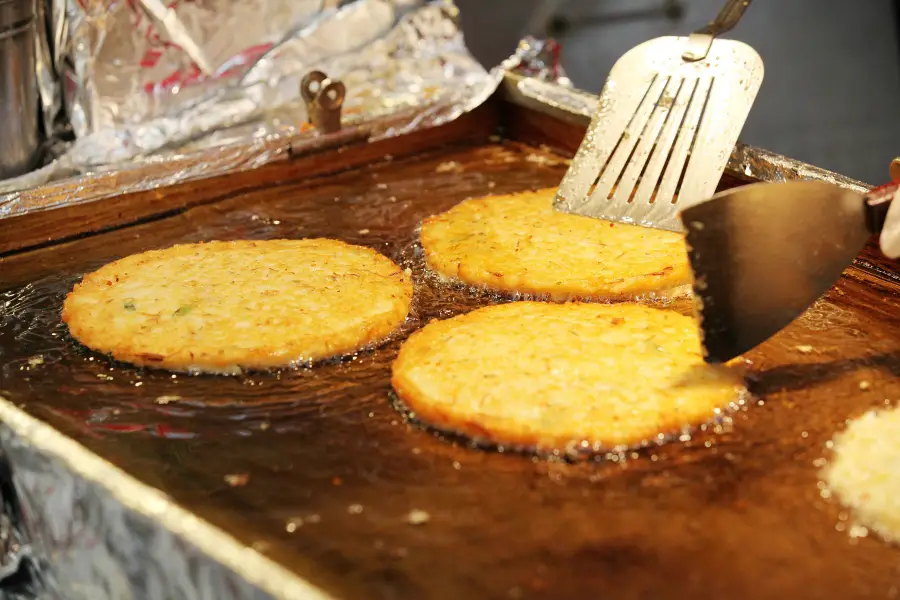
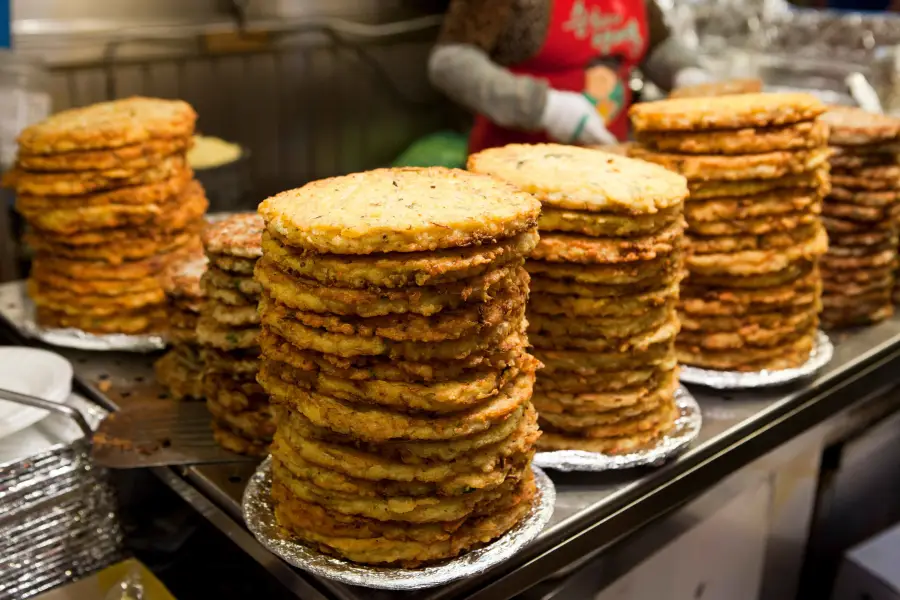
The irresistible aroma of freshly cooked bindaetteok naturally stops passersby in their tracks. Made with mung bean batter mixed with bean sprouts, kimchi, and green onions, then fried until crispy, it’s Seoul’s iconic street food that’s especially craved on rainy days. When you take a bite, you’ll experience the perfect contrast of a crispy exterior and moist interior.

Since these pancakes are quite large, it’s good to share them with friends or family. Enjoying them with makgeolli (rice wine) or dongdongju (traditional rice wine) lets you fully experience the market’s vibrant atmosphere and warm ambiance.
Here’s the best Bindaetteok shop to visit in Gwangjang Market
Sunhui-ne Bindaetteok
Wonjosoonghine Bindaetteok is a traditional Korean pancake (bindaetteok) restaurant located in Gwangjang Market, Jongno-gu, Seoul, operating since 1994. Their signature dishes include mung bean pancakes, made by grinding mung beans on a millstone, and meat patties, both known for their savory and crispy taste using fresh ingredients. The restaurant is easily recognizable by its red sign at the entrance of the alley near Gwangjang Market’s North Gate 2.
The Instagram-Famous “Addictive” Gimbap
Another popular dish at Gwangjang Market is “mayak gimbap” (literally “addictive rice rolls”). As the name suggests, its taste is so good that you’ll keep craving for more.

Unlike regular gimbap, these are made thin and small, perfect for eating in one bite. They’re filled with vegetables like carrots and spinach seasoned with a special sauce, along with egg strips. The rolls have a distinctive texture – crispy on the outside and tender on the inside.

What makes these rolls unique is that they’re served with spicy mustard sauce – the combination of the savory rolls and zesty mustard creates an unforgettable taste. At just 2,500 won per serving, they’re an affordable snack perfect for enjoying while exploring the market. Visit in the morning to try them fresh and warm, right after they’re made.
Here’s the best “Addictive” Gimbap place to visit in Gwangjang Market
Mayak Kimbap
Monyo Gimbap is a snack shop located in Gwangjang Market, Jongno-gu, Seoul, operating since 1975. Its signature dish, ‘Mayak Gimbap’ (literally ‘narcotic gimbap’), consists of bite-sized rolls dipped in a soy sauce-based dip, known for their addictive taste. The menu also includes tteokbokki (spicy rice cakes), oden (fish cakes), and nokdu bindaetteok (mung bean pancakes).
A Paradise of Fresh Sashimi and Raw Beef
The seafood market at Gwangjang is the place to find the freshest seafood. At the sashimi center, you can enjoy seasonal fish prepared right on the spot at prices much lower than regular sushi restaurants.

You can choose from various fish including flounder, salmon, and sea bass according to your preference. Once you select your fish, skilled merchants will prepare your sashimi with expert precision. Raw beef (yukhoe) is another market specialty. Made with fresh Korean beef, yukhoe is seasoned with a sweet and spicy sauce and sesame oil, creating a perfect harmony of flavors. It’s especially delicious when mixed with raw egg yolk. Even those unfamiliar with raw beef can comfortably enjoy this dish here, as it’s exceptionally tender and fresh.
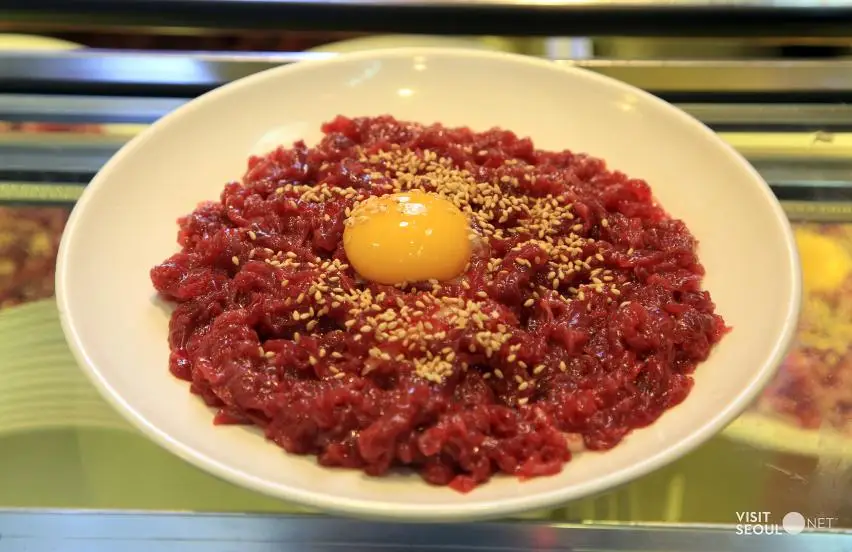
The fresh Korean beef yukhoe creates a perfect blend of sweet and spicy seasoning with nutty sesame oil, and it’s particularly delicious when mixed with raw egg yolk. Even if you’re new to raw beef, the dishes here are so tender and fresh that you can enjoy them without hesitation.
Here’s a list of recommended Fresh Sashimi and Raw Beef to visit in Gwangjang Market.
Jeollado Raw Fish Restaurant
Jeollado Hoejip is a seafood restaurant located in Gwangjang Market, Jongno-gu, Seoul, offering fresh assorted sashimi at reasonable prices. A single serving of assorted sashimi is priced at 10,000 KRW, providing excellent value and a variety of seafood options.
Jinju Yukhoe 1st Branch
Jinju Yukhoe is a raw beef specialty restaurant located in Gwangjang Market, Jongno-gu, Seoul, offering fresh yukhoe (Korean-style raw beef) and yuk sashimi at reasonable prices. Signature dishes include yukhoe, yuk sashimi, and yukhoe tangtangi (raw beef mixed with raw octopus), as well as traditional pancakes like nokdujeon (mung bean pancake).
The Colorful World of Traditional Hanbok and Fabrics
The second floor of Gwangjang Market is a paradise of hanbok and fabrics.
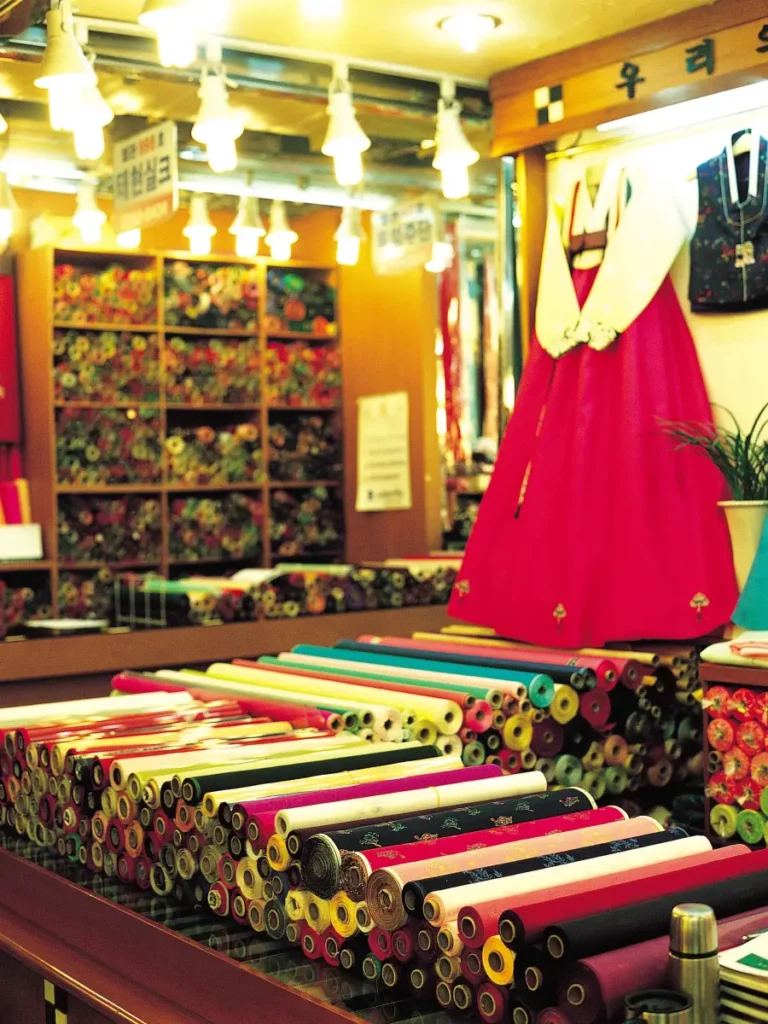

Walking through the corridors, you’ll feel like you’re walking on a rainbow, from vibrant silks to luxurious brocades. Just looking at the intricate patterns and beautiful colors of hanbok allows you to appreciate the beauty of traditional Korean clothing.

If you find hanbok or accessories that catch your eye while browsing, they make wonderful souvenirs. There’s also a delightful variety of traditional items for sale, such as Korean fans and norigae (traditional ornaments), making window shopping here quite enjoyable.
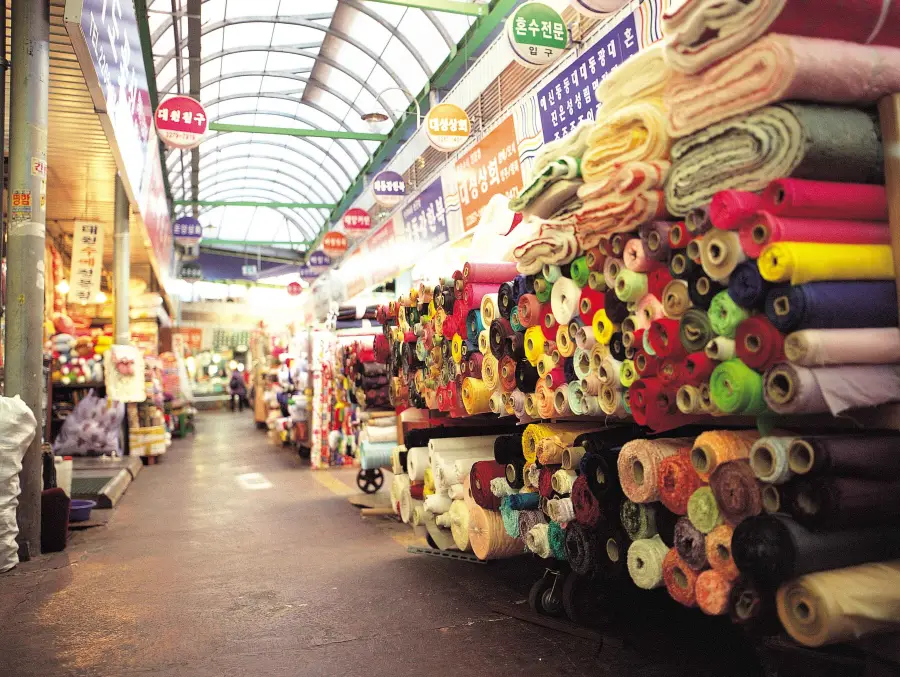

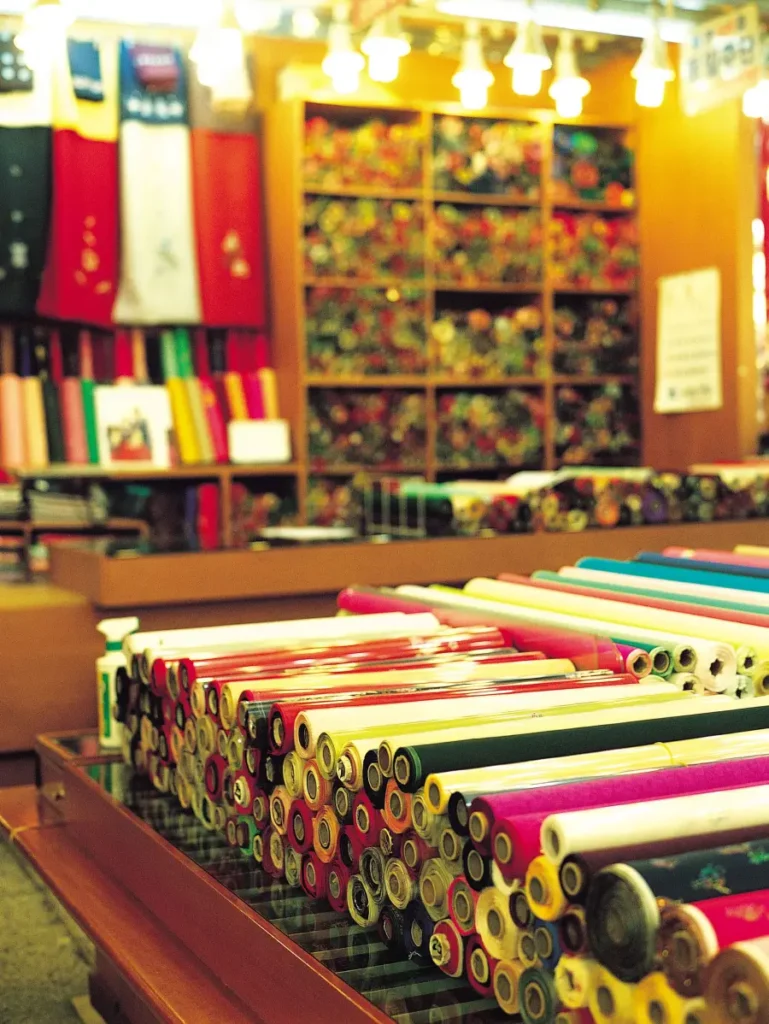
Vintage Clothing and Thrift Shopping
Another charm of the second floor is its vintage shops. From cute vintage clothing to unique fashion items, you can enjoy the excitement of treasure hunting.

You can find retro fashion items popular among young people at affordable prices. Each store has its own unique style of clothing, and the thrill of finding one-of-a-kind pieces is part of the appeal.
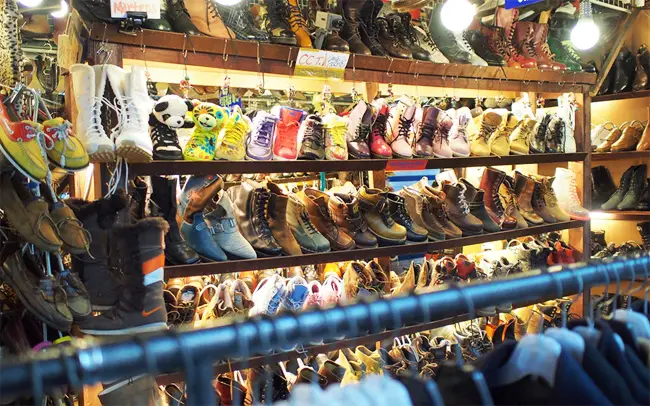
The vintage shops are most lively in the afternoon, so we recommend visiting after lunch.
Here’s the best Vintage Shop to visit in Gwangjang Market
Dobuy Vintageshop
Dubai Vintage is a vintage clothing boutique located in Jongno-gu, Seoul, offering a curated selection of high-quality vintage apparel from various brands. Notably, rare items such as Christian Dior summer knit dresses are available. The store deals exclusively in authentic products, providing trust to its customers.
Street Food Tour: Where Tradition Meets Modern
The market’s alleys are lined with various street foods.

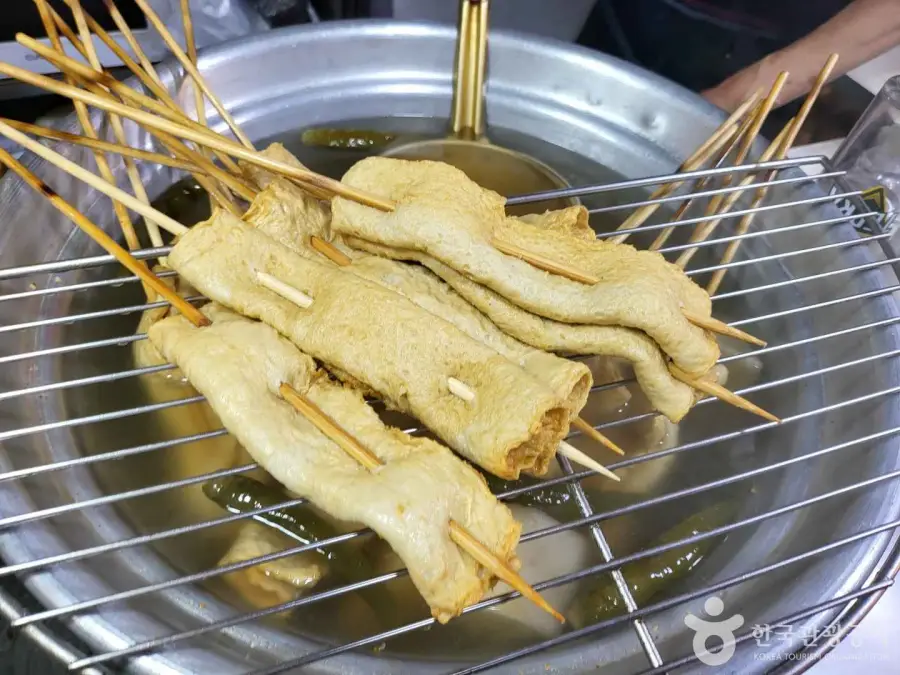
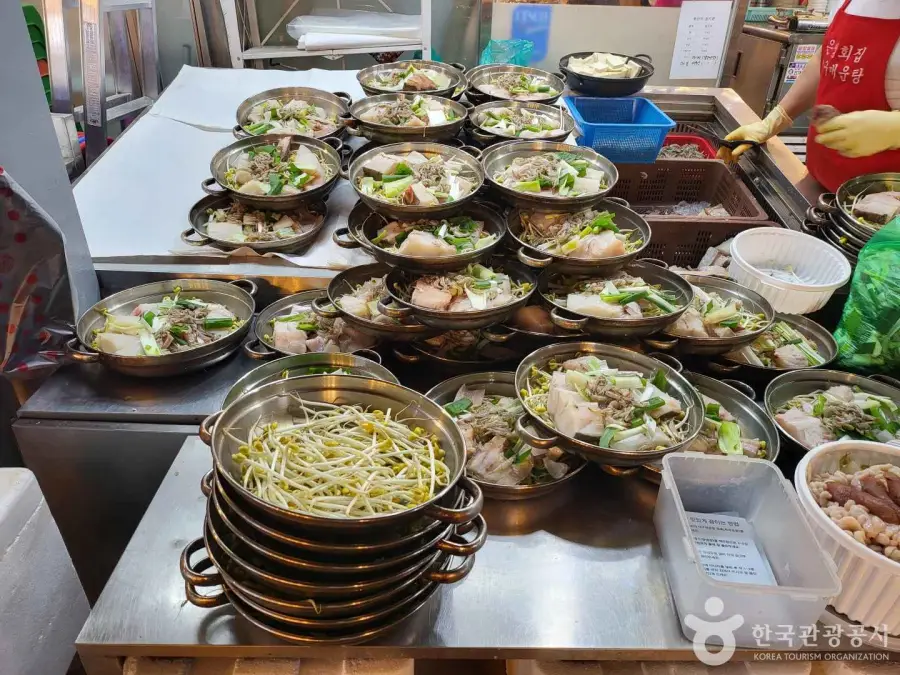
From traditional tteokbokki (spicy rice cakes), sundae (blood sausage), and fried snacks to modern favorites like cheese hot dogs and takoyaki, you can experience both old-school Korean snacks and contemporary street food. Venture deeper into the market to discover hidden food gems.

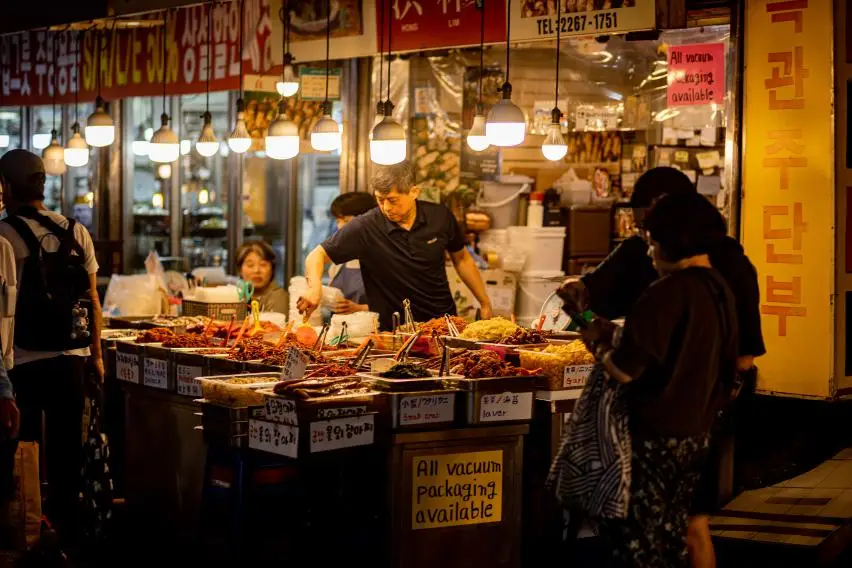

Don’t miss traditional snacks like chewy gangjeong (sweet rice puffs) and hangwa (traditional Korean sweets). These traditional treats offer insight into Korea’s historic snack culture.
Exploring Banchan (Side Dish) Shops
The banchan shops in Gwangjang Market capture the authentic taste of Korean home cooking. You’ll find various fermented foods from doenjang (soybean paste), gochujang (red pepper paste), and kimchi to different types of pickled vegetables and jeotgal (fermented seafood).

The shops are full of seasonal side dishes. You can find shepherd’s purse namul and pickled wild chives in spring, cucumber kimchi in summer, perilla leaf kimchi in fall, and dongchimi (radish water kimchi) in winter. Shop owners gladly offer samples, so you can taste before buying. Vacuum packaging services are available for tourists.

Traditional Rice Cake Shops at Gwangjang Market
At Gwangjang Market’s rice cake shops, you can discover traditional Korean rice cakes.
They offer various types like chapssal-tteok (sticky rice cake), baekseolgi (white steamed rice cake), yakshik (sweet rice with nuts), and injeolmi (sticky rice cake covered with powder). The steamed rice cakes are particularly special as they’re made to order and can be enjoyed warm. Rice cakes are also important in Korean holidays – you can find garaetteok during Lunar New Year and songpyeon during Chuseok.
These days, they also sell fusion rice cakes like matcha and cream cheese varieties, which are becoming popular among younger generations.
Here’s a list of recommended Rice Cake Shops to visit in Gwangjang Market.
A 60-Year-Old Traditional Rice Cake Shop
60 Years Traditional Tteokjip is a traditional rice cake shop located in Gwangjang Market, Jongno-gu, Seoul, boasting over 60 years of history. Their signature item, chapssaltteok (glutinous rice cake), offers a chewy texture harmonized with moderately sweet red bean filling, allowing customers to enjoy freshly made rice cakes.
Arigotgan
Arigotgan is a traditional handmade Korean confectionery shop that offers healthy sweetness by using radish rice syrup and fermented citron syrup instead of adding sugar. Their signature items include soft and crispy handmade Oranda and glutinous rice Yugwa, traditional snacks enjoyed by all ages. You can find their stores in various locations, including Jeju Dongmun Market and Ganghwa Gyodong Hangwa.
Exploring Analog-Style Accessories at Gwangjang Market
Hidden throughout Gwangjang Market are shops that feel like treasure troves. You can find retro-style items that are hard to find in modern shopping malls, such as vintage clocks, antique pottery, and accessories with traditional patterns.


Vintage accessories and decorative items are especially popular among tourists due to their affordable prices. It’s interesting to imagine the history and stories behind each item.

On weekends, you can discover even more diverse accessories at pop-up stores run by young artists.
Here’s a list of recommended Accessories Shops to visit in Gwangjang Market.
Quiz Sunday
Queen’s Sunday is a boutique located in Euljiro, Jung-gu, Seoul, offering European-inspired interior accessories and illustrated postcards. Situated on the 14th floor of the Jungang Deco Plaza, it’s a 5-minute walk from Exit 7 of Euljiro 3-ga Station.
SOUTEM
Soutem Jongno Gwangjang Market Branch is a unmanned accessory shop located at 210 Jongno, Jongno-gu, Seoul. The store offers a variety of items, including phone cases, stickers, keyrings, and postcards, featuring diverse designs. It is conveniently situated just a 30-second walk from Exit 8 of Jongno 5-ga Station.
Creating Special Memories with Handcrafted Items
Gwangjang Market is also home to various handcrafted items made by skilled artisans.
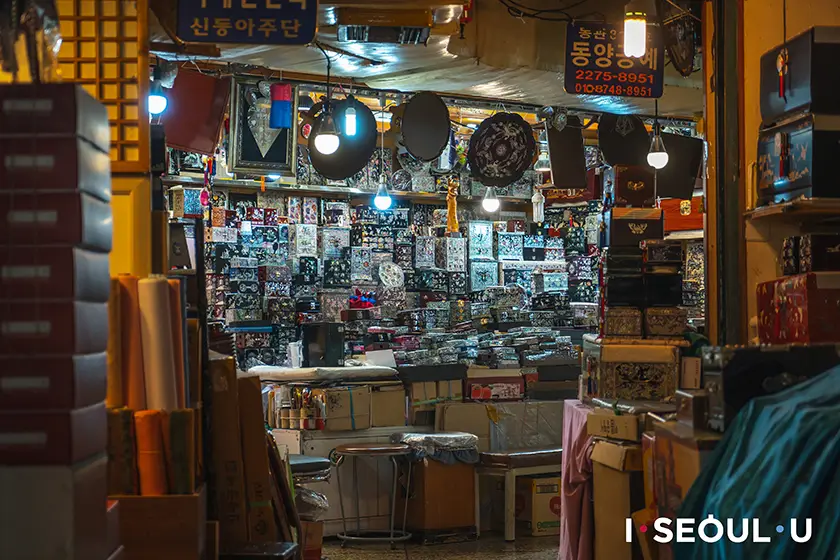
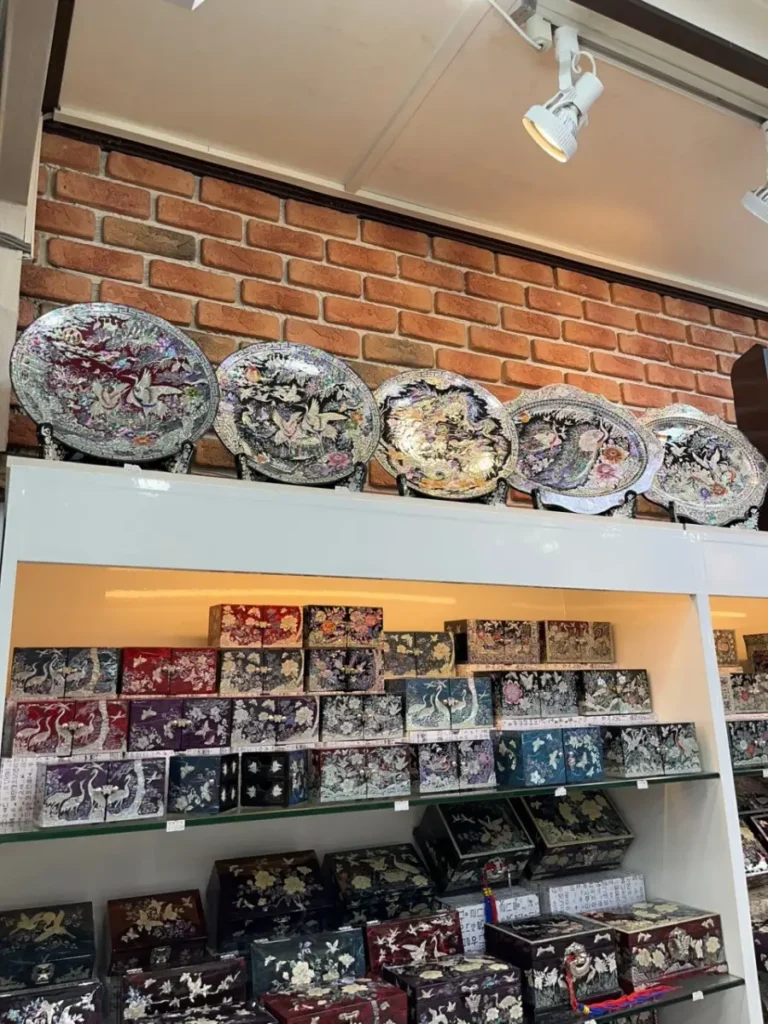
From leather crafts to beaded accessories and hand-knitted items, you’ll find products carefully made with attention to detail. These pieces carry a special charm that mass-produced items simply can’t match. The artisans are happy to explain their crafting process, allowing you to take home not just the item but also its story.

Some shops even offer custom-made items, perfect if you’re looking for a one-of-a-kind souvenir.
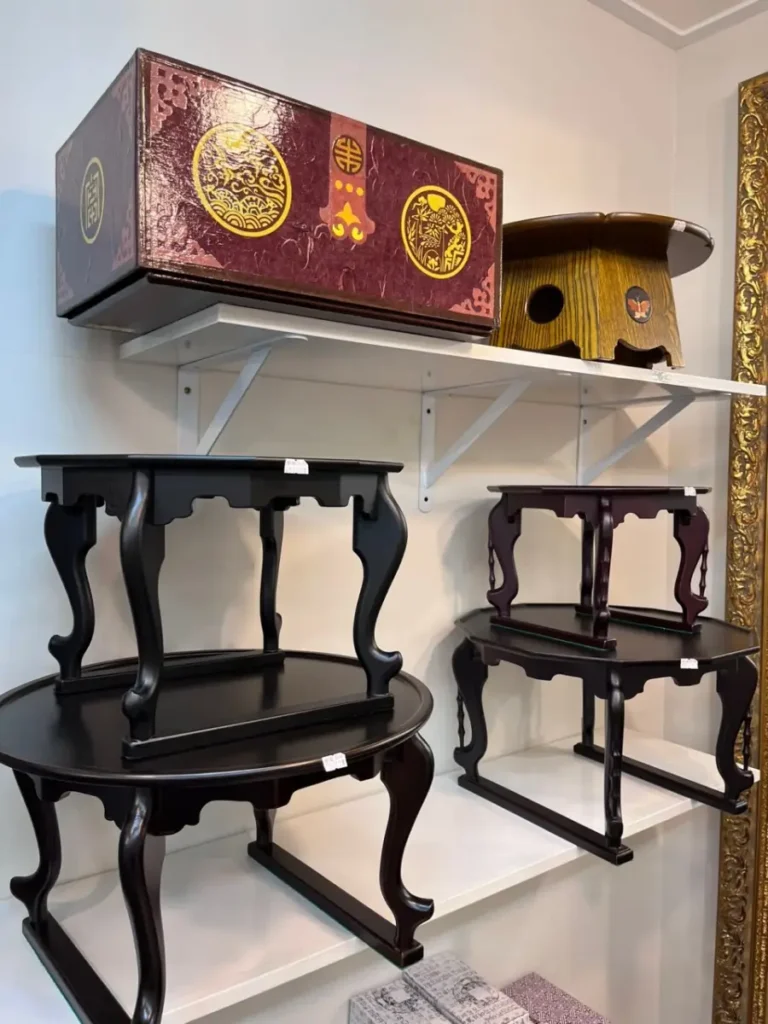

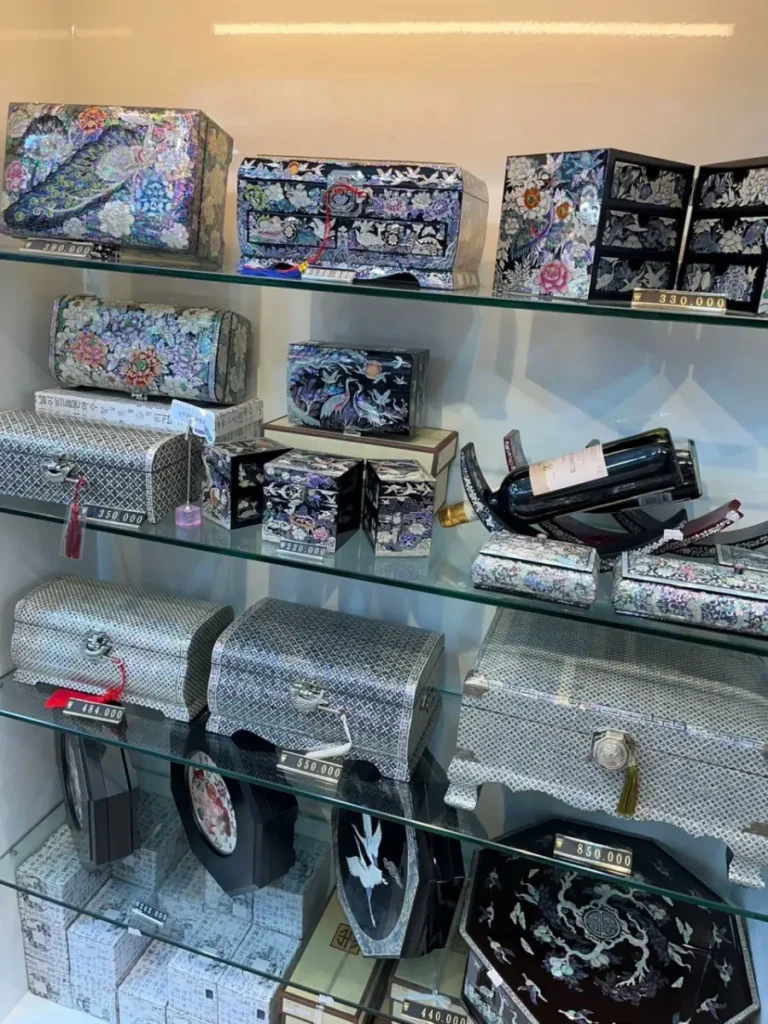
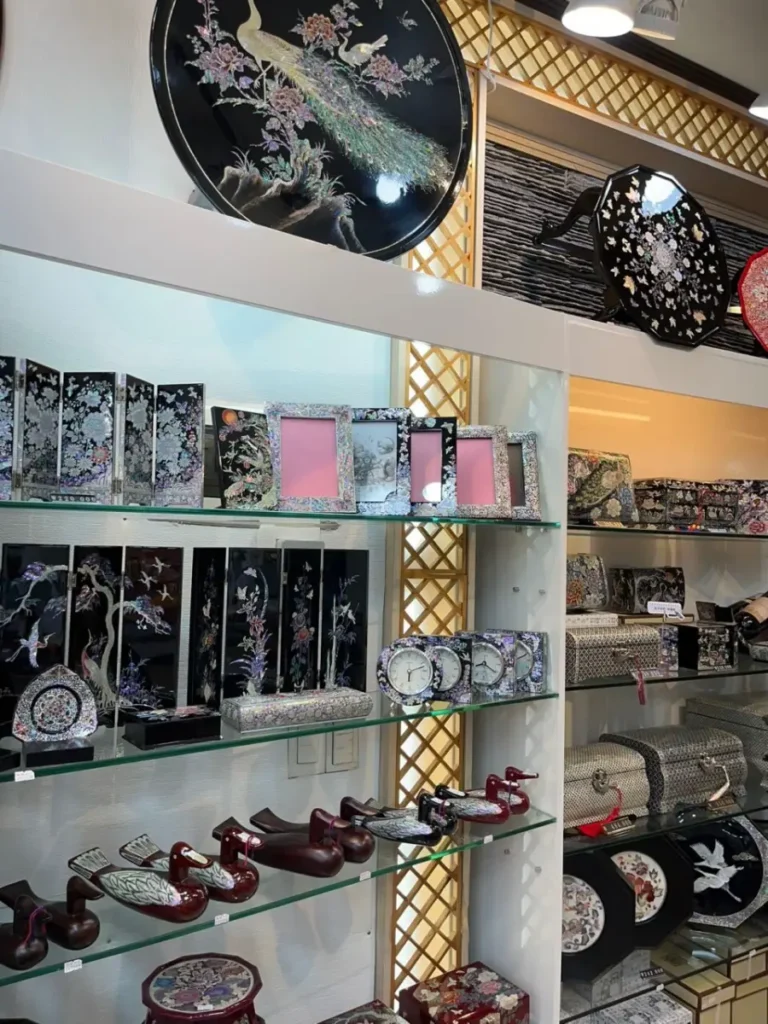
Here’s the best Handcrafted Items Shop to visit in Gwangjang Market
Mido Crafts
Mido Gongyesa is a traditional craft shop located in Gwangjang Market, Jongno-gu, Seoul, offering a variety of Korean traditional crafts such as mother-of-pearl jewelry boxes, hand mirrors, and business card holders. Popular among foreign tourists for souvenirs, it is easily accessible on foot from Jongno 5-ga Station Exit 7.
Insider Tips for
Gwangjang Market Like a Local
- Timing Your Visit
- Price Negotiation
- Restroom Guide
- Using the Market Map
- Preparing Cash
- Bringing the Right Bag
Timing Your Visit Like a Local
To fully enjoy Gwangjang Market, choosing the right time to visit is crucial. The market is least crowded between 11 AM and 3 PM on weekdays.

During these hours, you can explore the market at a leisurely pace and find seats at restaurants without waiting. We recommend visiting on weekdays if possible, as weekends tend to get very crowded with tourists.
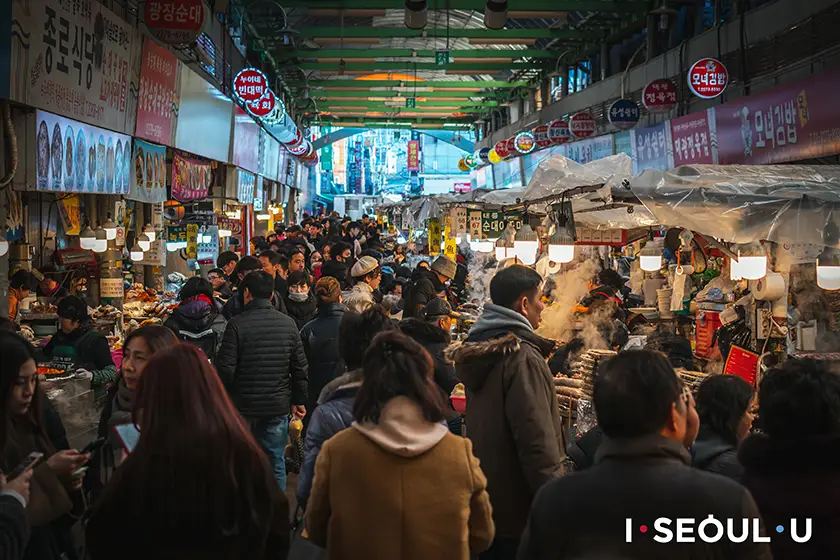
Especially avoid the lunch rush hour between 12 PM and 1 PM when local office workers flood the market. While most food stalls open in the morning, visiting around 11 AM is ideal for trying the freshest food.
The Art of Price Negotiation
Price negotiation is part of the Gwangjang Market experience. Haggling is particularly common for clothing, accessories, and small items.

However, note that food stalls generally have fixed prices. When negotiating, avoid offering prices that are too low as this might offend the merchants – starting at 70-80% of the asking price is recommended. Prices can vary between shops, so it’s wise to compare prices at 2-3 different stores.
You can naturally get better discounts when buying in bulk, so shopping with friends for group purchases can be a good strategy.
Restroom Guide
Finding restrooms while exploring the market can be challenging.
Gwangjang Market has three public restrooms: one in the central corridor of the first floor and two at either end of the second floor. However, as market restrooms might not always be well-maintained, we recommend using facilities at nearby cafes or fast-food restaurants if you prefer cleaner options.
The restrooms at Euljiro 3-ga Station and Jongno 5-ga Station are also well-maintained alternatives. It’s helpful to note these locations before starting your market tour for a more comfortable visit.
Using the Market Map
Gwangjang Market is large with many alleys, making it easy to get lost on your first visit.
It’s helpful to take a photo of the directory map at the market entrance. You can also download the store layout map from the official Gwangjang Market website beforehand. If you have specific stores or foods you want to try, be sure to note their locations in advance.
If you get lost, follow the main corridors to get your bearings. The store numbers and zone markers throughout the market serve as good guideposts.
Preparing Cash
Cash is essential at Gwangjang Market. While larger stores accept credit cards, many snack vendors and small shops still only take cash.
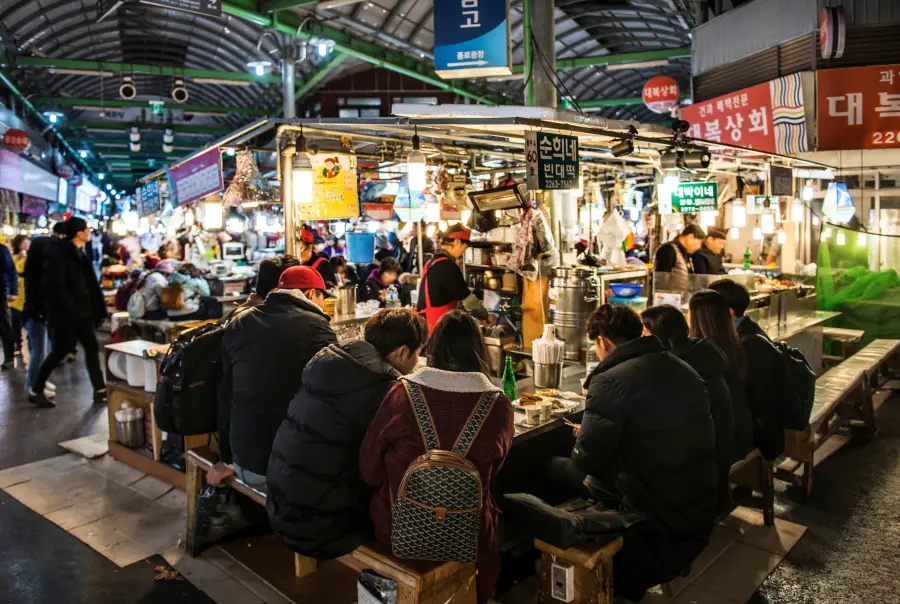
Cash is particularly convenient at food stalls where most items cost less than 5,000 won. Paying in cash while chatting with merchants helps you experience the market’s warm atmosphere.
While there are ATMs near the market, they can have long lines on weekends and holidays, so prepare cash in advance. For safety, rather than carrying large amounts, keep only what you need in your wallet.
Bringing the Right Bag
You’ll likely end up shopping more than expected at Gwangjang Market. Between buying tasty side dishes, fruits, and cute accessories, your items can quickly add up.

Prepare a spacious bag for your shopping. A backpack or eco-bag that leaves your hands free is ideal. Since the market floor can be uneven in places, carrying bags are more convenient than rolling luggage.
If you plan to buy larger items, bringing a folding shopping cart is a good idea. This also helps reduce plastic bag usage and protect the environment.
Is Gwangjang Market
Worth Visiting?
Meeting Seoul’s Flavors and Warmth
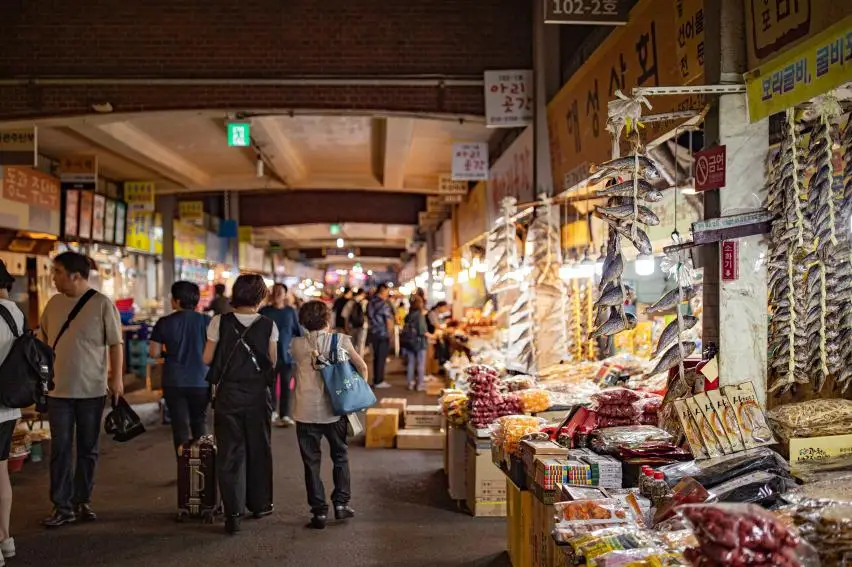
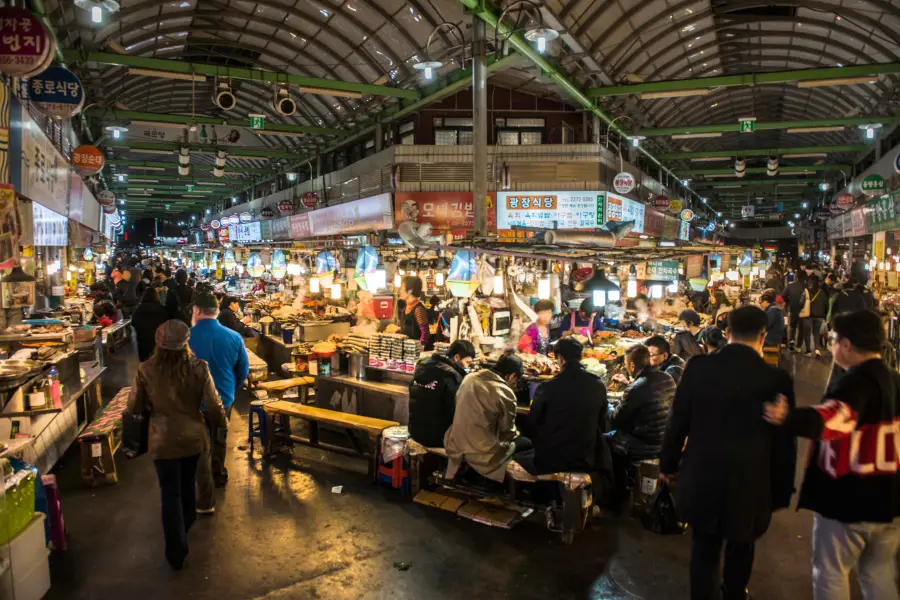
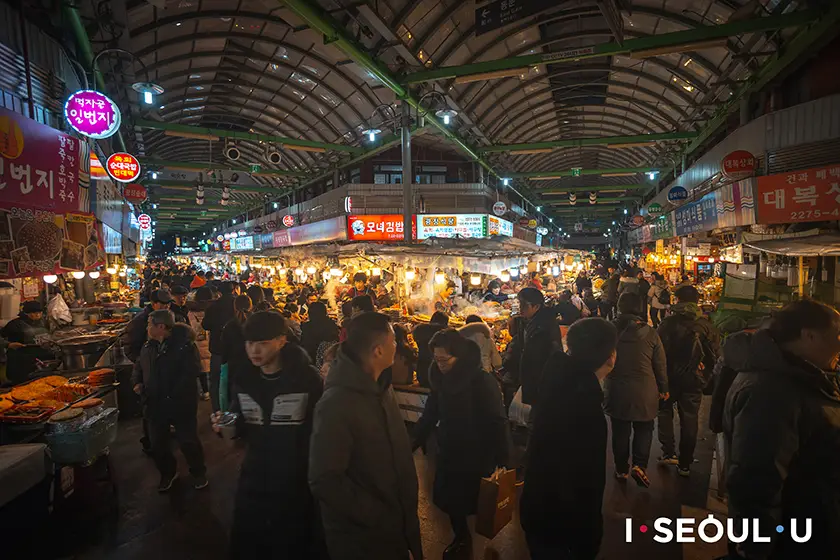
Gwangjang Market is more than just a market – it’s a special place where Seoul’s history and culture come alive. For over a century, this place has held countless stories. The sound of sizzling bindaetteok, the friendly voices of merchants, and the market’s vibrant atmosphere continue unchanged.

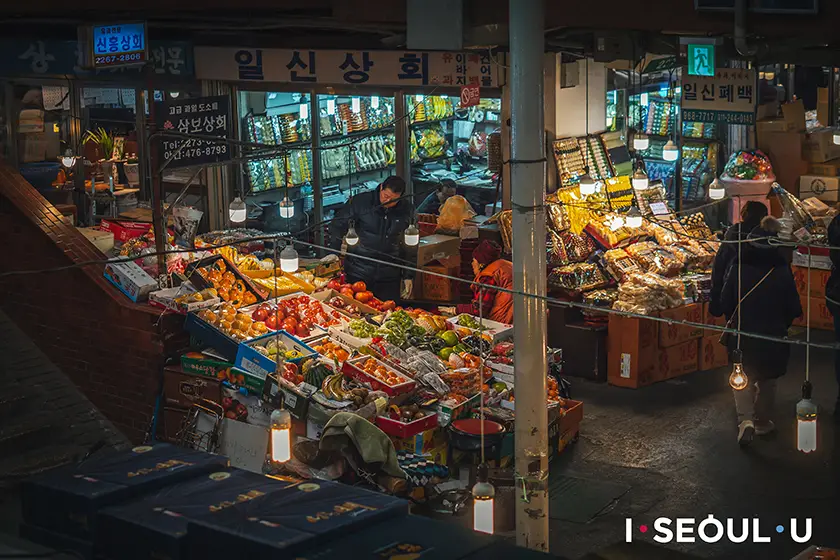
Walking through the market alleys, you’ll discover a harmonious blend of old Seoul’s charm and modern energy. From grandmothers’ homemade banchan shops to trendy vintage stores, various attractions transcend generations. The warm hospitality you’ll encounter in the food alley adds a special flavor unique to Gwangjang Market.
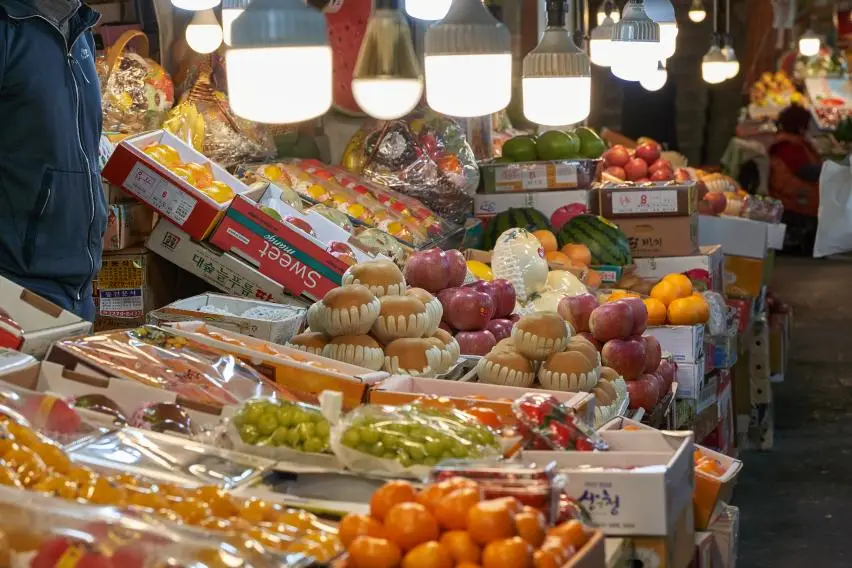
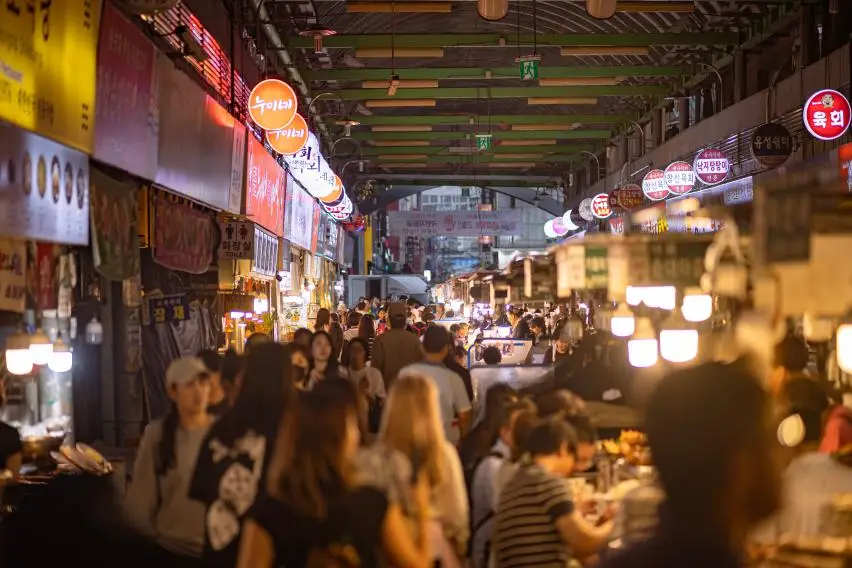

Even in this rapidly changing city, Gwangjang Market remains a space filled with everyday life and memories. It’s a place where you can hunt for delicious food with friends, smile at unexpectedly cute finds, and feel your heart warm from the lively market atmosphere. This is Gwangjang Market.
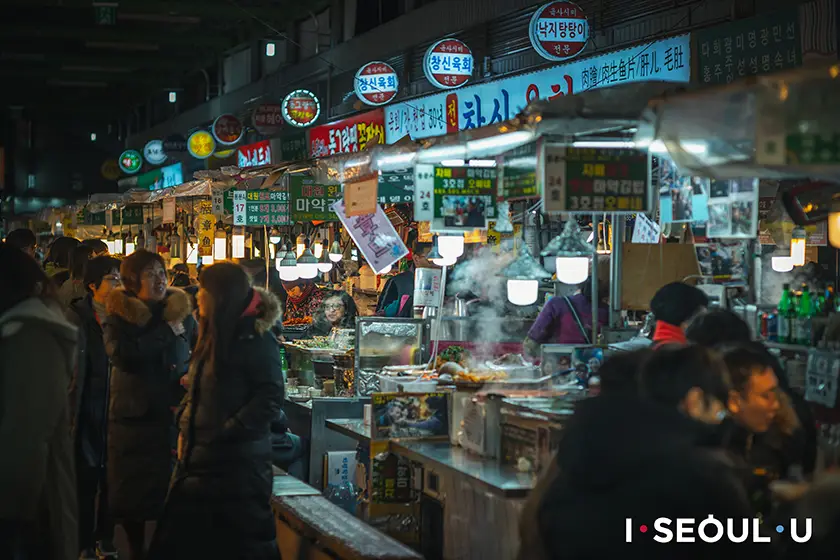
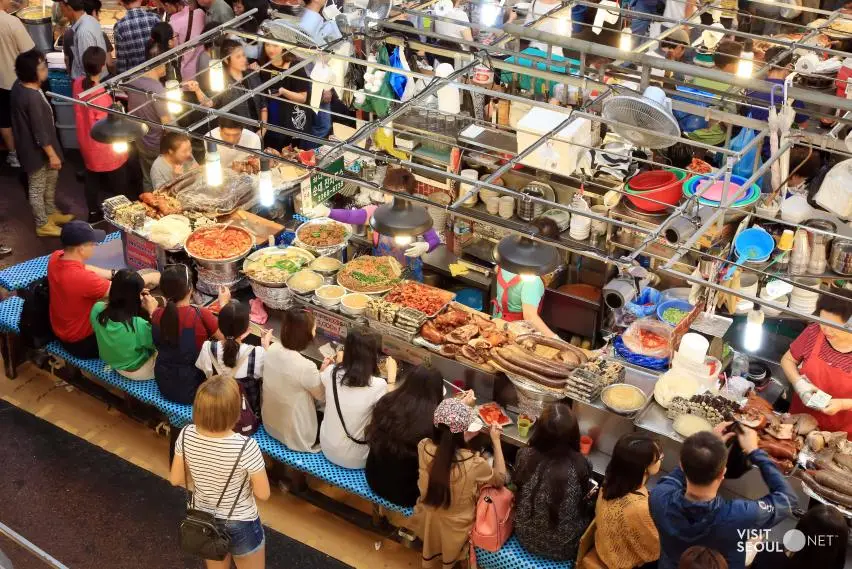
Come spend a special day at Gwangjang Market. Walking through the friendly market alleys, experiencing old Seoul, filling your stomach with delicious food, and your heart with beautiful things – you’re sure to create unforgettable memories. Gwangjang Market is always ready to welcome you warmly.
Frequently Asked Questions
4. Review
What Travelers Are Saying
5. Near by
Top Spots to Explore
Near Gwangjang Market
- Ikseon-dong
- Cheonggyecheon
- Jongmyo Shrine
Ikseon-dong: Seoul’s Hip Neighborhood Where Traditional Hanok Charm Meets Trendy Vibes
Just an 8-minute walk from Gwangjang Market, Ikseon-dong is one of Seoul’s newest hotspots.


This area, lined with century-old hanok houses, has recently been reborn with a young, modern touch. The narrow alleys are filled with charming cafes, restaurants, and boutique shops. What makes this place special is how the stores maintain the traditional hanok atmosphere while incorporating contemporary design elements.


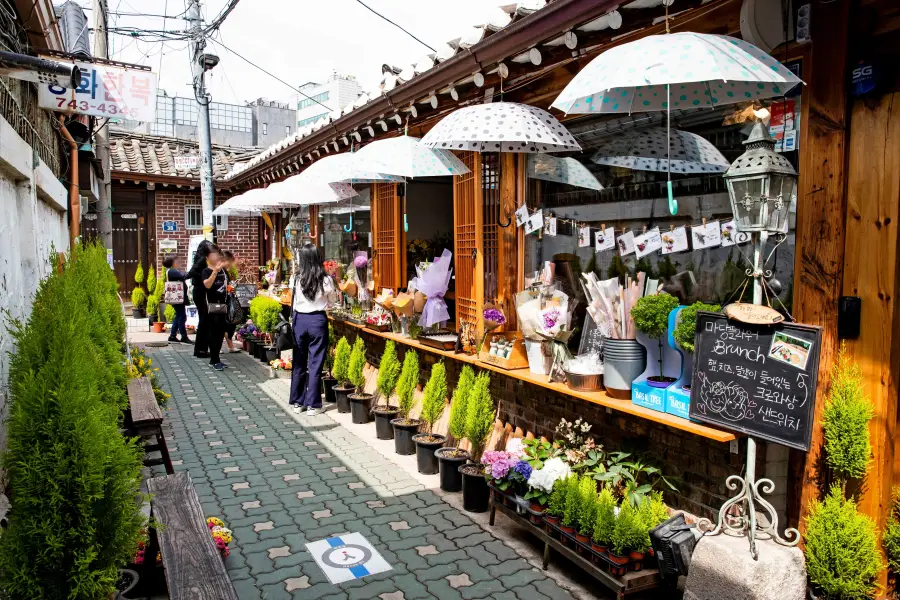
As you explore the alleys and their unique shops, time seems to fly by. With plenty of Instagram-worthy photo spots, it’s especially popular among social media enthusiasts. After enjoying a meal at Gwangjang Market, we recommend taking a relaxing cafe break in Ikseon-dong.
Cheonggyecheon Stream: Discovering Seasonal Beauty Along an Urban Waterway
Cheonggyecheon Stream, flowing right in front of Gwangjang Market, is one of Seoul’s premier urban recreational spaces.
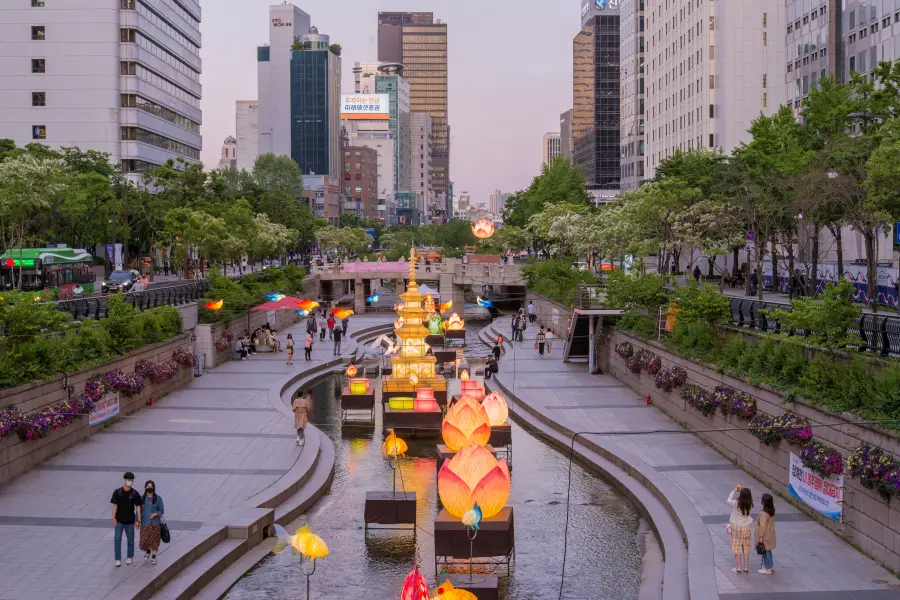
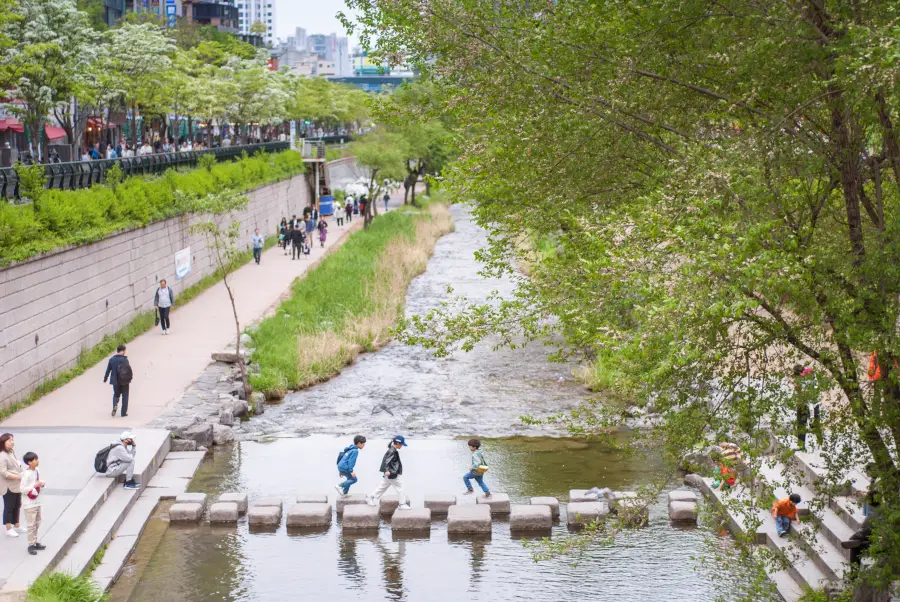
This 10.84km stream offers a peaceful walking experience with the soothing sound of flowing water. Each season brings its own charm – cherry blossoms in spring, cool water festivals in summer, and dazzling light festivals in winter.

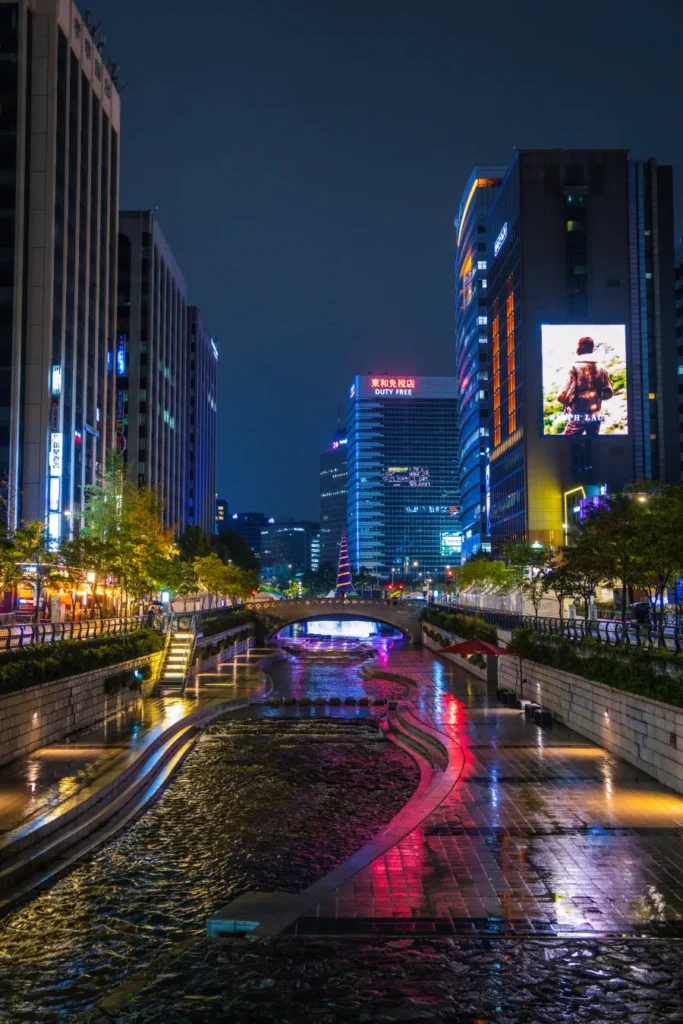
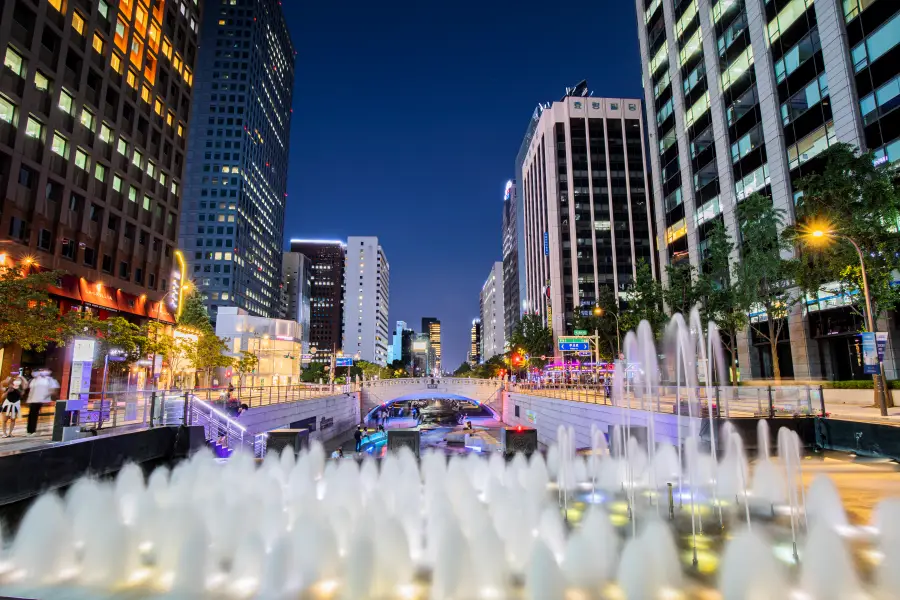
Near Gwangjang Market, the stream features beautiful lighting, murals, and art installations under its bridges. At sunset, the romantic scenery along Cheonggyecheon makes for a perfect end to your day of exploration.
Jongmyo Shrine: Experiencing the Spirit of Joseon in a Serene Palace
Jongmyo Shrine, a UNESCO World Heritage site just a 10-minute walk north of Gwangjang Market, breathes with the living history of the Joseon Dynasty.


This shrine, which houses the ancestral tablets of Joseon kings and queens, showcases magnificent scale and elegant architectural beauty. Walking through the shrine grounds offers a serene atmosphere that contrasts beautifully with the bustling energy of Gwangjang Market.


The well-maintained trees and tranquil ponds make it perfect for a peaceful stroll. On Saturdays, you can experience traditional culture through Jongmyo Jerye ritual music performances. Admission is 3,000 won for adults, with free entry on the last Wednesday of each month. It’s highly recommended if you’re looking for a peaceful retreat after your market tour.

